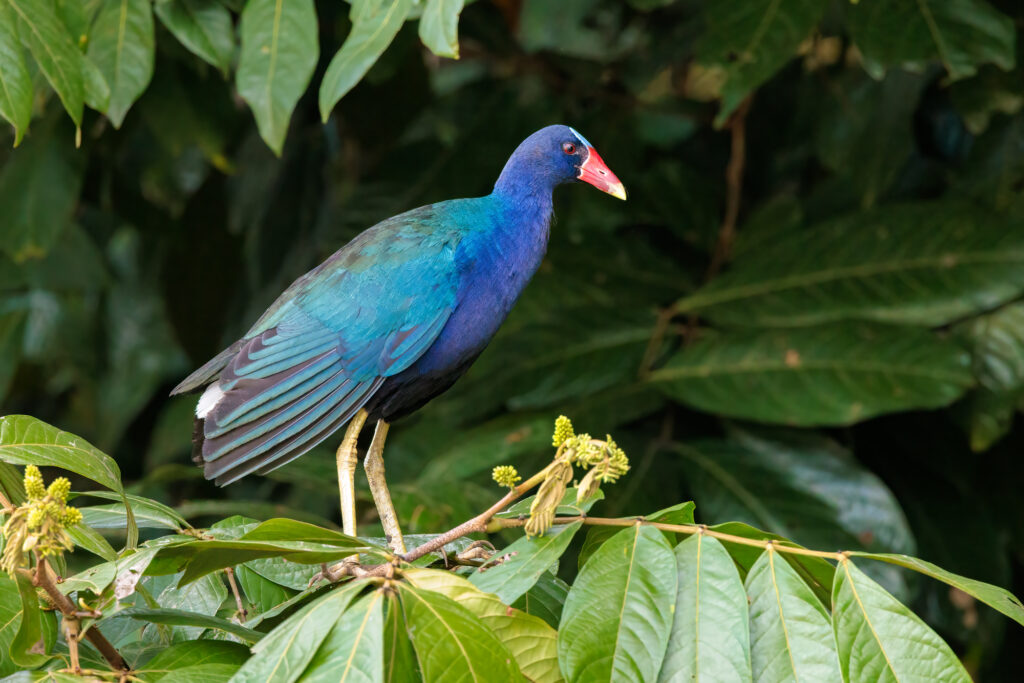Wyoming is a spacious place to live. I mean, for it to be the tenth-largest state of the United States, yet one of the least populous, I bet social distancing wasn’t that hard up there.
Of course, I said “up” because Wyoming is one of the Mountain States – but there’s another reason for that.
See, there’s something special about the sky of Wyoming – it’s far from being monochromatic. How could it be with the 81,367 colorful birds that call Wyoming home?
That’s why the best gift to give to an avid birder is probably a flight ticket to Wyoming. Assuming you’re that lucky birder who got the ticket, let’s take a look through the range of birds in Wyoming that you don’t want to miss!
Red Birds in Wyoming
Vermilion Flycatcher
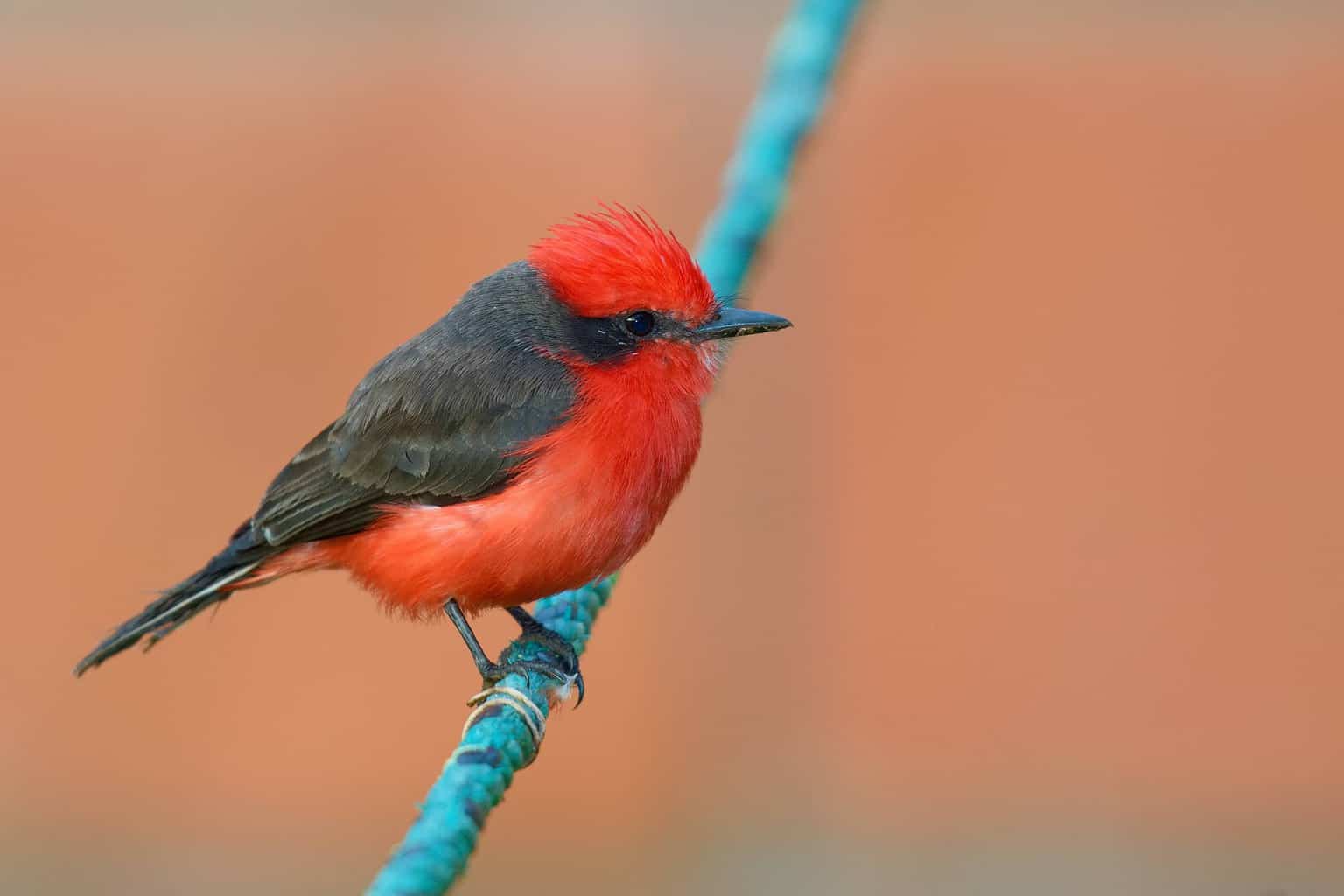
- Scientific name: Pyrocephalus obscurus
- Length: 5.1 – 5.5 in
- Weight: 0.39 – 0.49 oz
- Wingspan: 9.4 – 9.8 in
This red-orange bird is called a flycatcher for a reason: it skillfully snatches flying insects after patiently waiting for the right moment.
Vermilion flycatchers get into position in a perch that’s no higher than 10 feet. Then, they scan the parameter until they get an insect in the scope.
That’s when they make a circle in the air, beginning and ending in the perch. It seems as though the prey just happens to be in their way.
You can spot this aviation master year-round since it roams the open-country skies all year long.
Summer Tanager
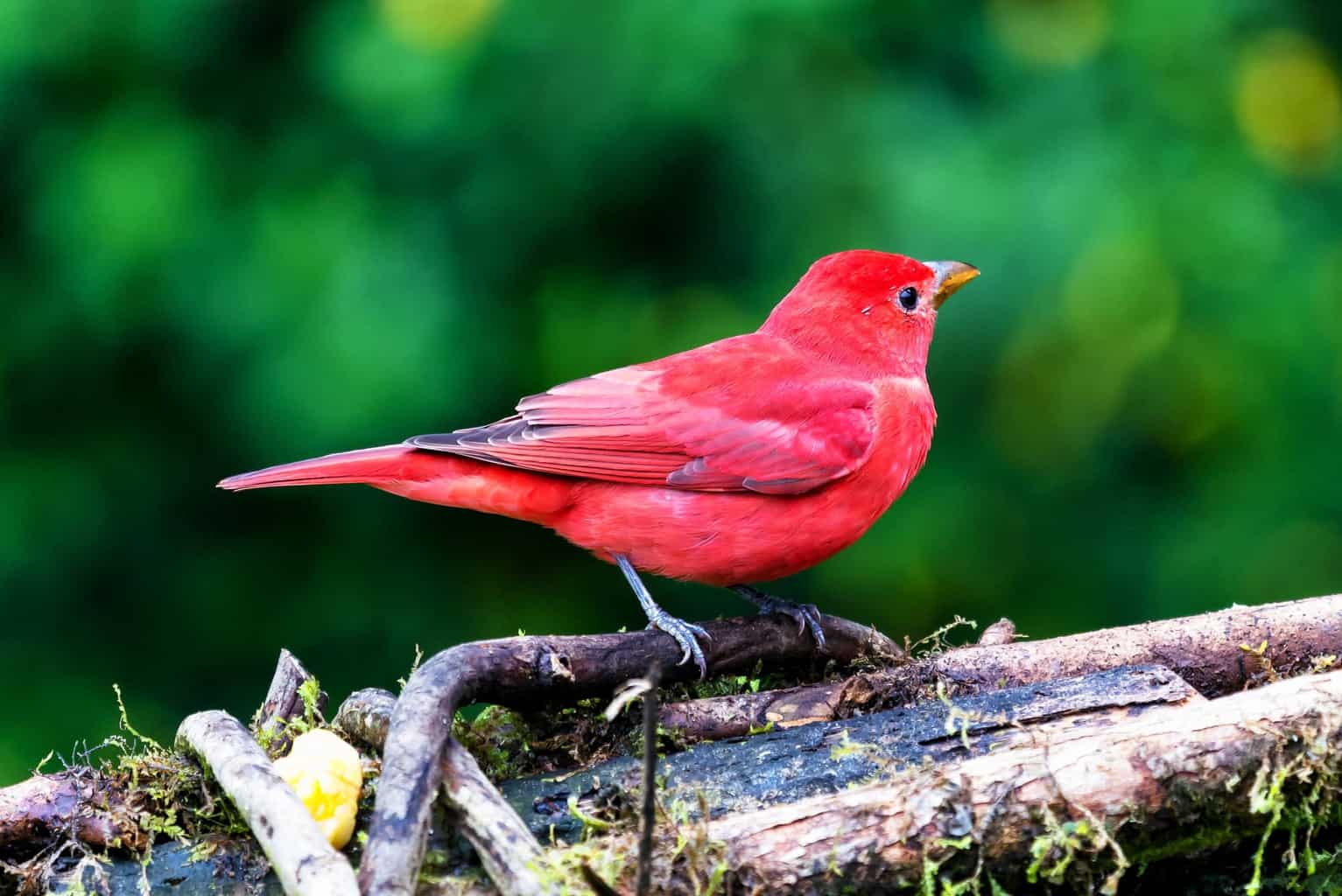
- Scientific name: Piranga rubra
- Length: 6.7 in
- Weight: 1.0 oz
- Wingspan: 11 – 11.8 in
The rosy red Summer tanager has a soft spot for berries, so if you want to attract it to your feeder, you know just the way. One thing about the Summer tanager that isn’t soft, though, is the way it treats, or rather mistreats, wasps.
They start by catching the wasp in flight and eating it. So far, that’s normal behavior in the animal kingdom: the strong eat, and the weak are meat. However, what comes next is nothing short of a war crime!
With the parent wasp out of the way, the Summer tanager breaks into the wasp nest and devours the little larvae. But let’s not rush to judgment here; maybe this bird is eating the larvae to reunite them with their parents – inside the safe haven of its gut.
Scarlet Tanager
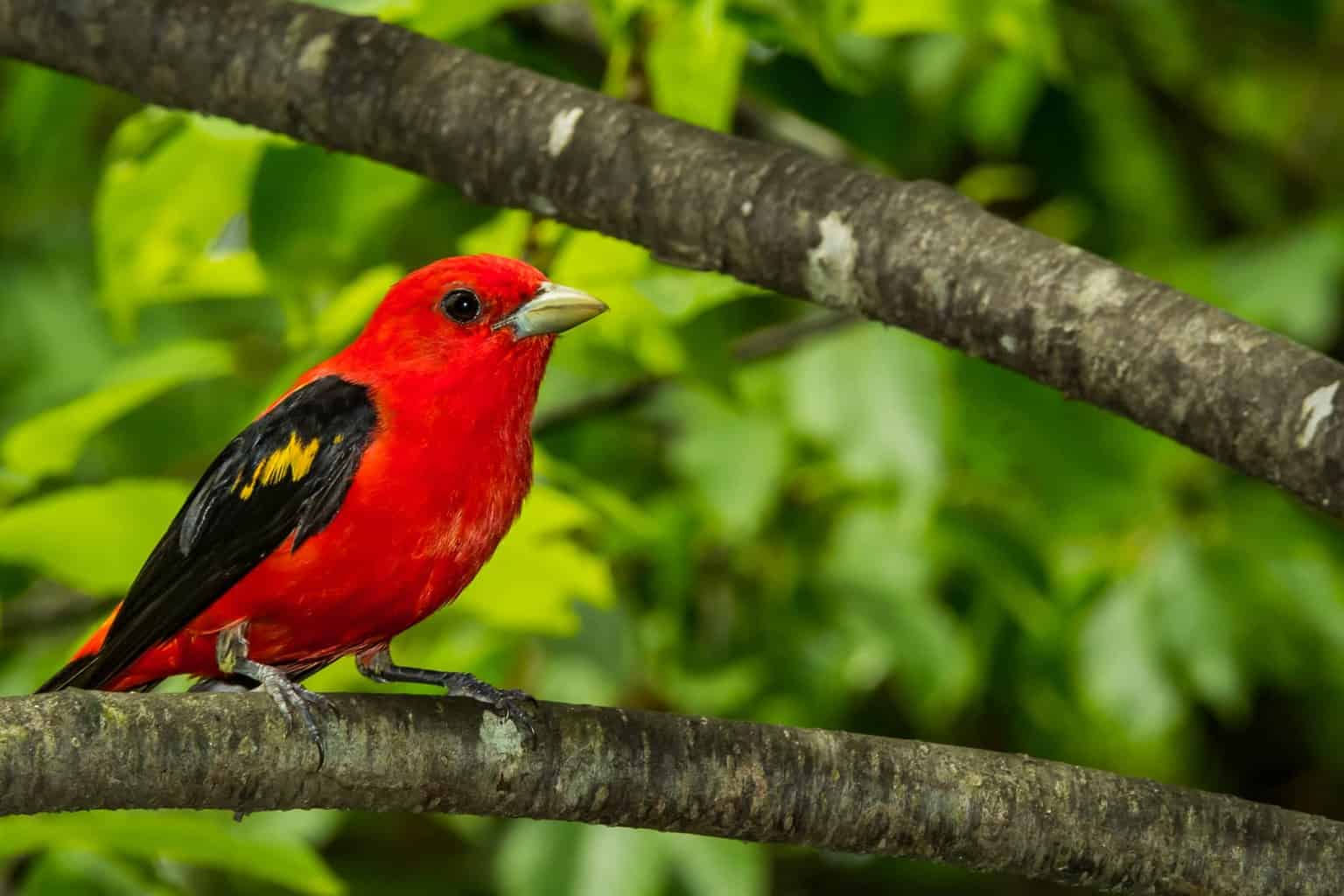
- Scientific name: Piranga olivacea
- Length: 6.3 – 7.5 in
- Weight: 0.83 – 1.34 oz
- Wingspan: 9.8 – 11.8 in
The Scarlet tanager is a species known for its eye-catching, traffic-light colors. You’ll first see the red male, which will “stop” you in your tracks. Then, the yellow female will enter the picture, calling for you to be “ready” to behold beauty.
Finally, the couple will make their way through the green canopy, demanding you to “go” after them so you don’t lose sight of that scene.
However, this blissful blend of traffic-light colors may not be always accessible. That’s because the Scarlet tanager likes to look for food way up high in the trees.
Red-Bellied Woodpecker
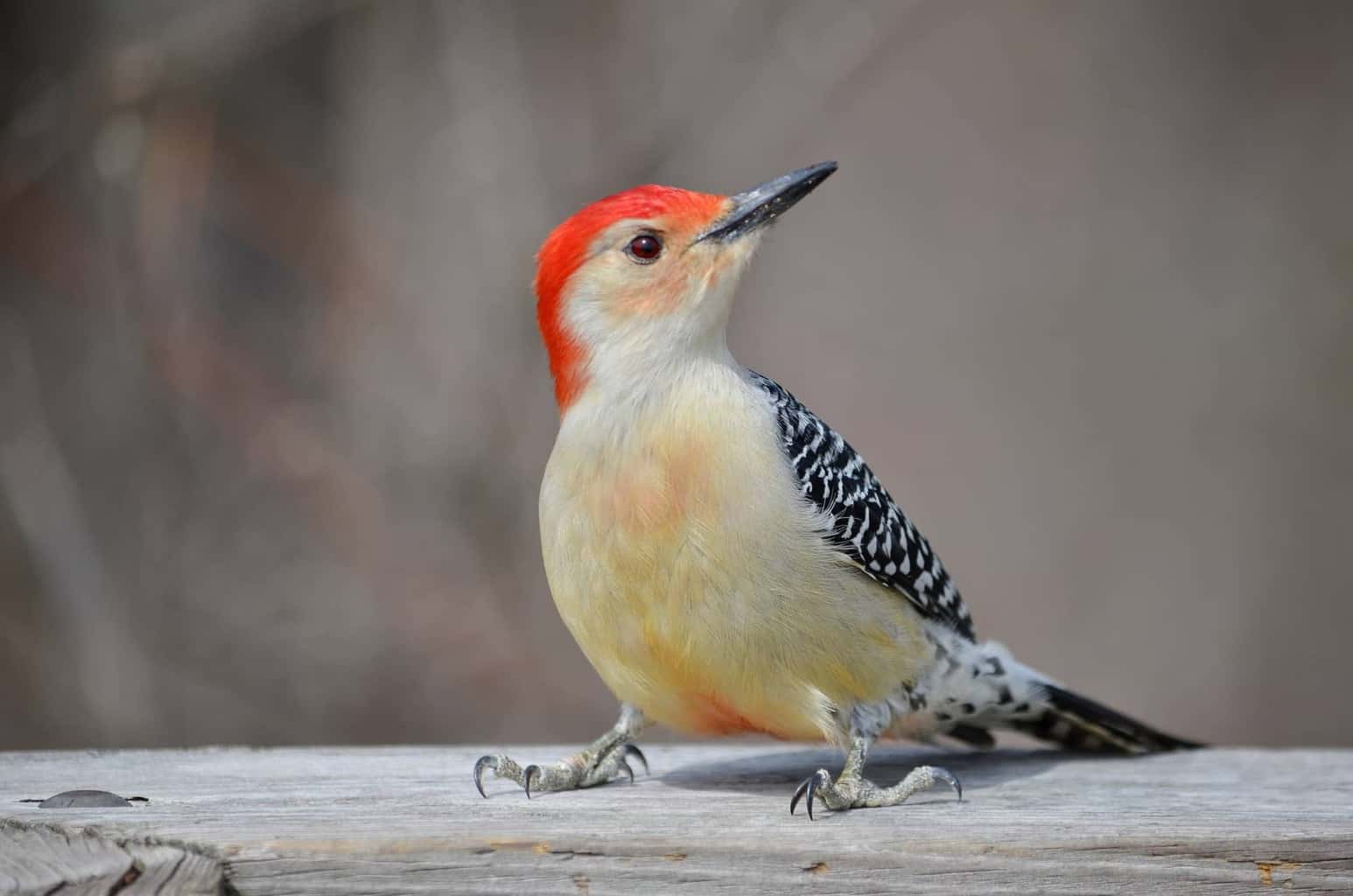
- Scientific name: Melanerpes carolinus
- Length: 9 – 10.5 in
- Weight: 2 – 3.2 oz
- Wingspan: 15 – 18 in
The Red-bellied woodpecker was declining in numbers because of the heated competition for survival in nature. This led the zebra-colored bird to change its game plan and start adapting to life in residential areas.
This strategy has served this woodpecker well since it managed to turn the tide in its favor, with the numbers now on an upward trajectory.
Now, let’s address the whole color thing. Yes, despite being called “red-bellied,” the red in its belly is barely visible. It can be better identified by its red head and the zebra-like body.
Red-Necked Phalarope
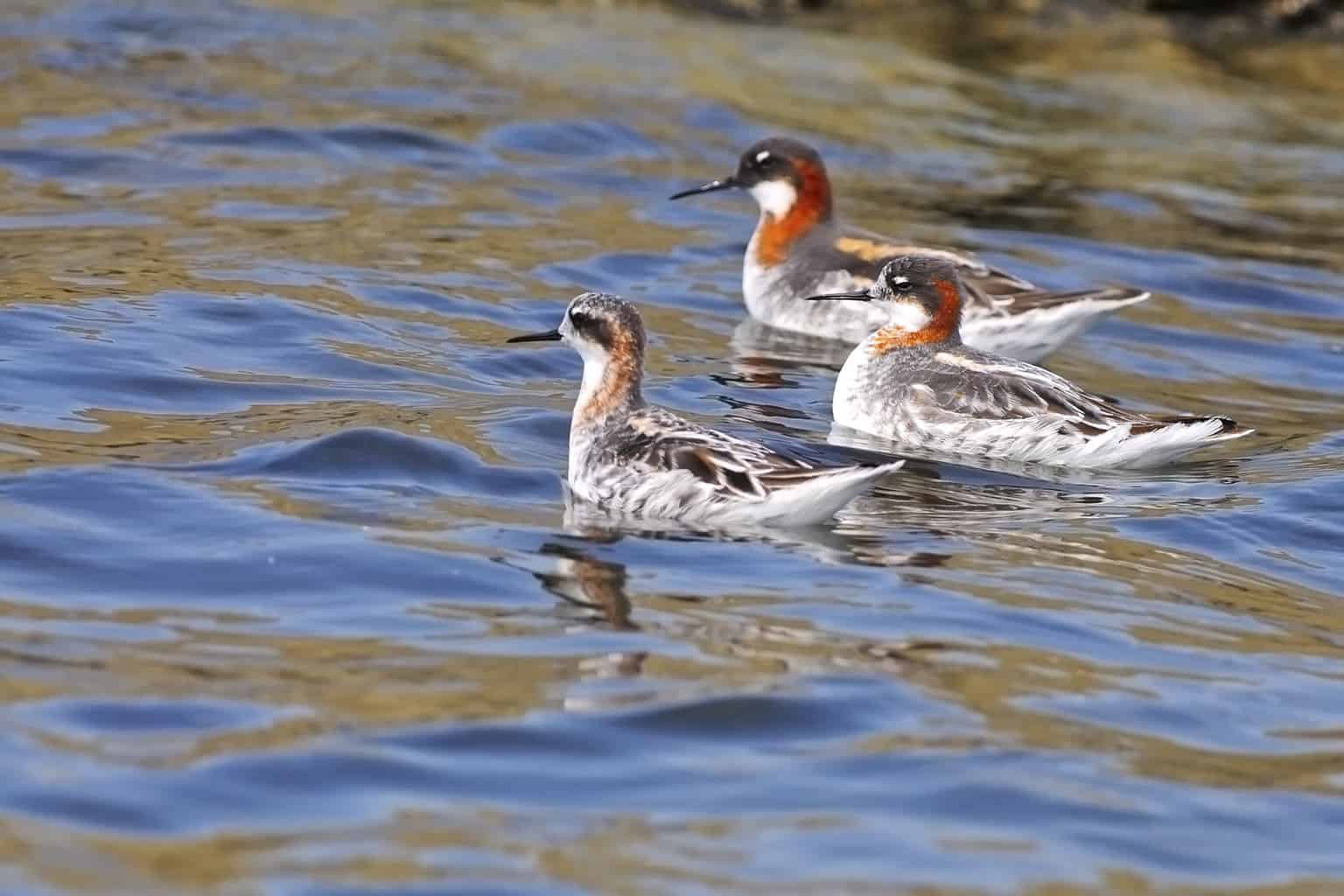
- Scientific name: Phalaropus lobatus
- Length: 7.1 in
- Weight: 1.2 oz
- Wingspan: 15 in
The bad news: the Red-necked phalarope spends the vast majority of its time at sea, far away from inland.
The good news: this bird does make frequent stops at ponds inland during its migration, presenting a unique opportunity for you to spot it.
There’s one more piece of bad news: when I said “ponds,” I left out a small detail – the Red-necked phalarope often stops at sewage ponds, as they’re rich in delicious insects. So, when you set out to sight this bird, don’t forget to bring along a nose clip.
Blue Birds in Wyoming
Blue-Headed Vireo
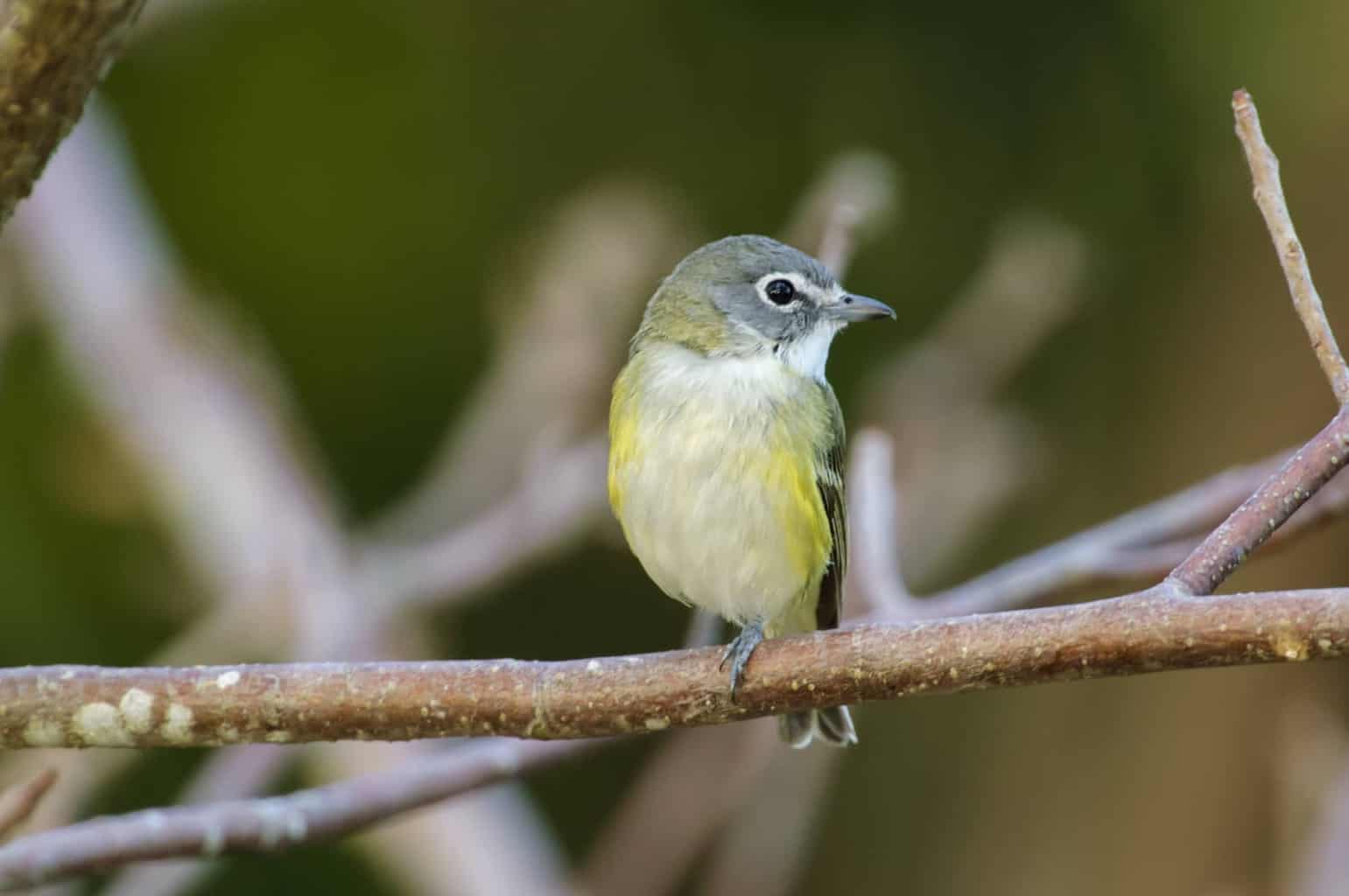
- Scientific name: Vireo solitarius
- Length: 5 – 5.8 in
- Weight: 0.46 – 0.67 oz
- Wingspan: 7.9 – 9.4 in
We, birders, shouldn’t call loners “lone wolves,” as most people do. How could we do that when we have a bird that exemplifies solitude: the Blue-headed vireo? Its scientific name is Vireo solitarius, alluding to its solitary inclination.
However, that doesn’t mean this grayish-blue bird doesn’t mate. Yes, the male puts in some extra work, as it builds multiple nests for the female to choose from.
Once the couple is wedded, though, the female reveals her jealous side, by driving away any other ill-advised female that intrudes on the nest.
Blue Grosbeak

- Scientific name: Passerina caerulea
- Length: 5.5 – 7.5 in
- Weight: 0.92 – 1.11 oz
- Wingspan: 10 – 11 in
While the male Blue grosbeak is largely blue, the dark color borders on black—at least until the sun shines on it; that’s when the blue hue makes its presence felt.
The Blue grosbeak feels at home when it’s deep inside tangled bushes. This might be bad news for you if you’re a traveler out to spot it.
However, if you’re a resident with lots of bushes in the backyard, then that’s good news. You just need to put up a feeder near the bushy area, and a touch of blue will bless your yard.
Lazuli Bunting
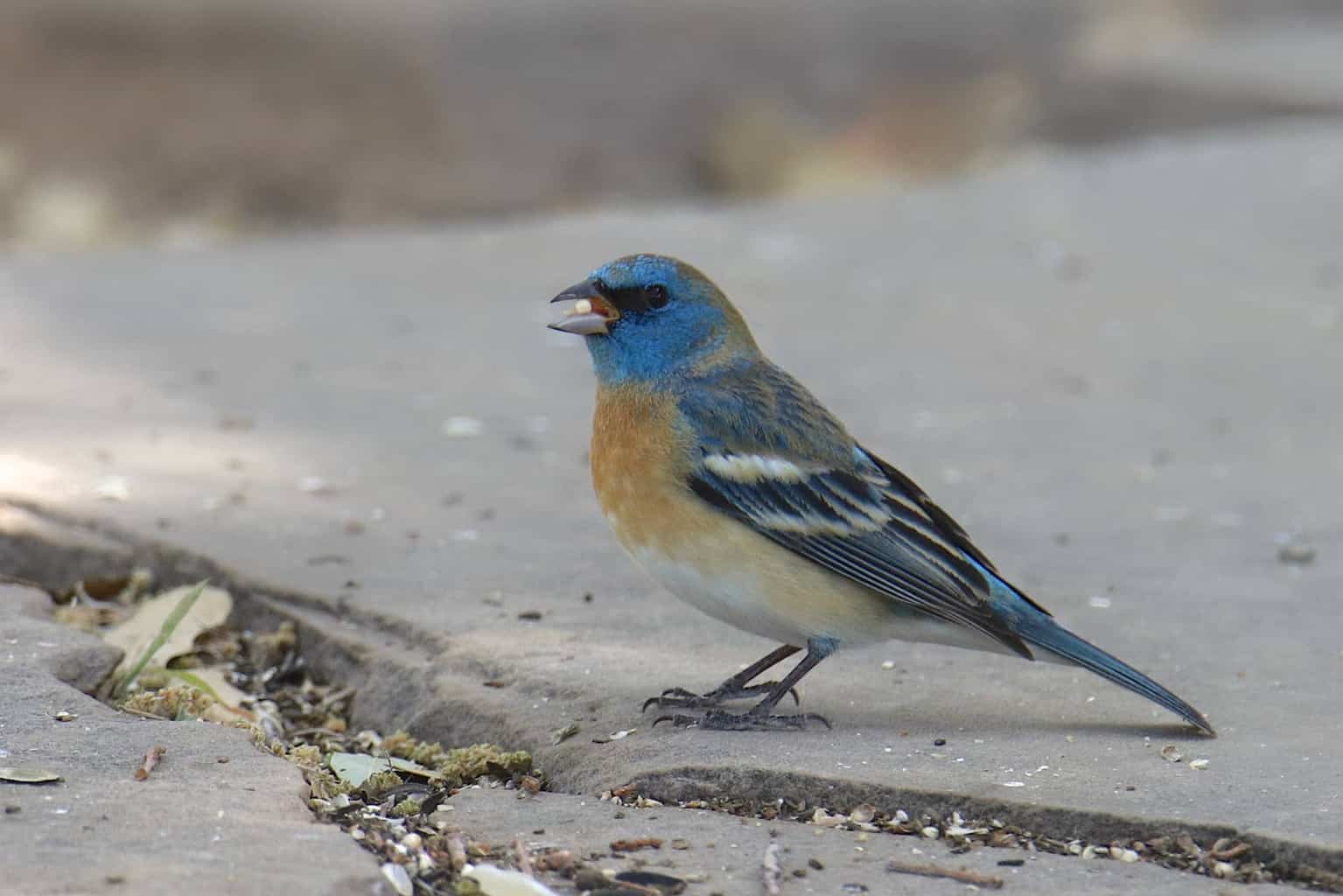
- Scientific name: Passerina amoena
- Length: 5.1 – 5.9 in
- Weight: 0.5 – 0.6 oz
- Wingspan: 8.7 in
With its namesake being the gemstone lapis lazuli, it’s no wonder that the Lazuli bunting has a celestial blue color. While this cute bird stands out with such a unique shade of blue, this is more than we can say about its singing.
In modern music, there’s this trend of sampling, where an artist takes bits and pieces of older songs to incorporate them into his work. That’s kind of what the Lazuli bunting does!
It keeps an ear out for the melodies other males sing in the vicinity, so it can mix them to come up with its own voice. I guess its singing can be unique, after all!
Mountain Bluebird
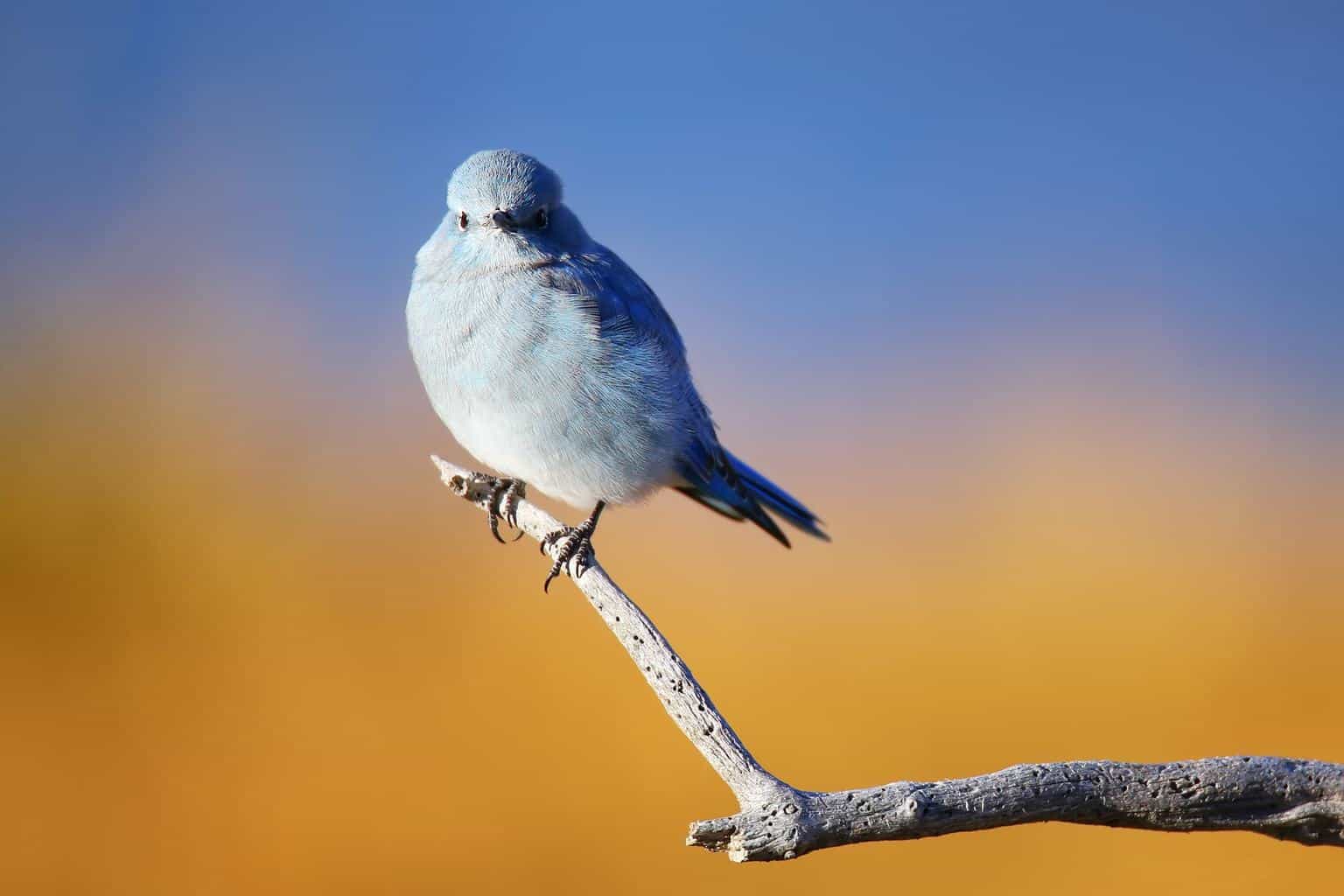
- Scientific name: Sialia currucoides
- Length: 6.1 – 7.1 in
- Weight: 0.85 – 1.31 oz
- Wingspan: 11.0 – 14.2 in
The Mountain bluebird likes to keep its circle tight, often preferring to migrate in smaller flocks. It also embraces diversity, as the company it keeps usually consists of different species.
Nonetheless, this bright-blue bird doesn’t stick to its habits, as it sometimes migrates alone and can also travel in flocks of around 50 birds.
Regarding its name, the Mountain bluebird is called this because it breeds on mountaintops. When winter comes, however, it becomes too cold up there, forcing the bird to, once again, break its habits.
Pinyon Jay
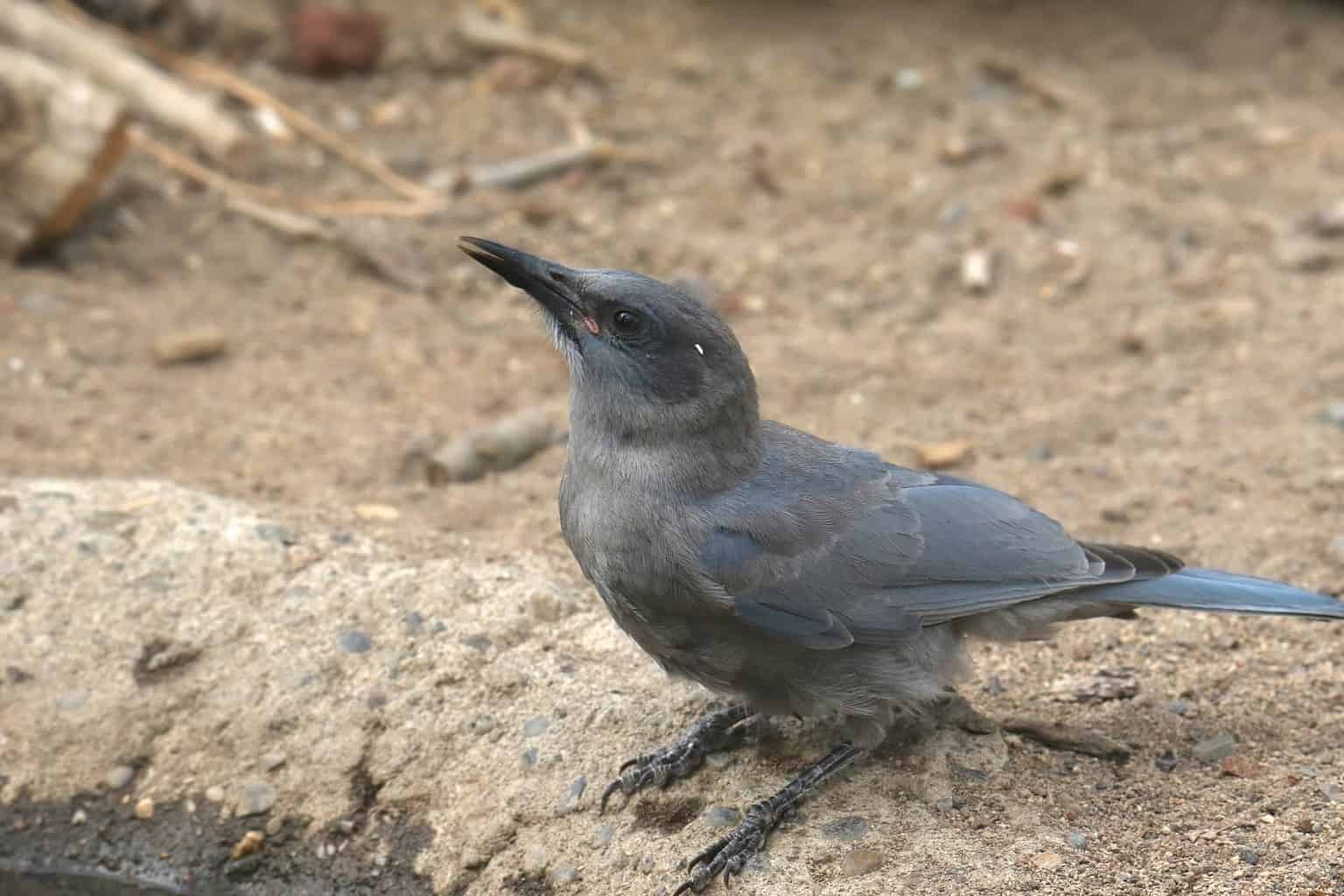
- Scientific name: Gymnorhinus cyanocephalus
- Length: 9 – 11 in
- Weight: 3.2 – 4.2 oz
- Wingspan: 18 in
The peculiar behavior of the Pinyon jay resembles that of honeybees. No, you didn’t hear that wrong. First, the Pinyon jay is an exceptionally social bird. It doesn’t only travel and search for food in flocks, but it also nests in colonies!
Moreover, the Pinyon jay stores food by burying it in the ground, so it can come back to it when food is scarce. So, if you find a huge “X” mark written in the sand in oak woods, don’t think that this is a pirate’s treasure – it’s just pine seeds, this jay’s favorite food.
Green Birds in Wyoming
Violet-Green Swallow
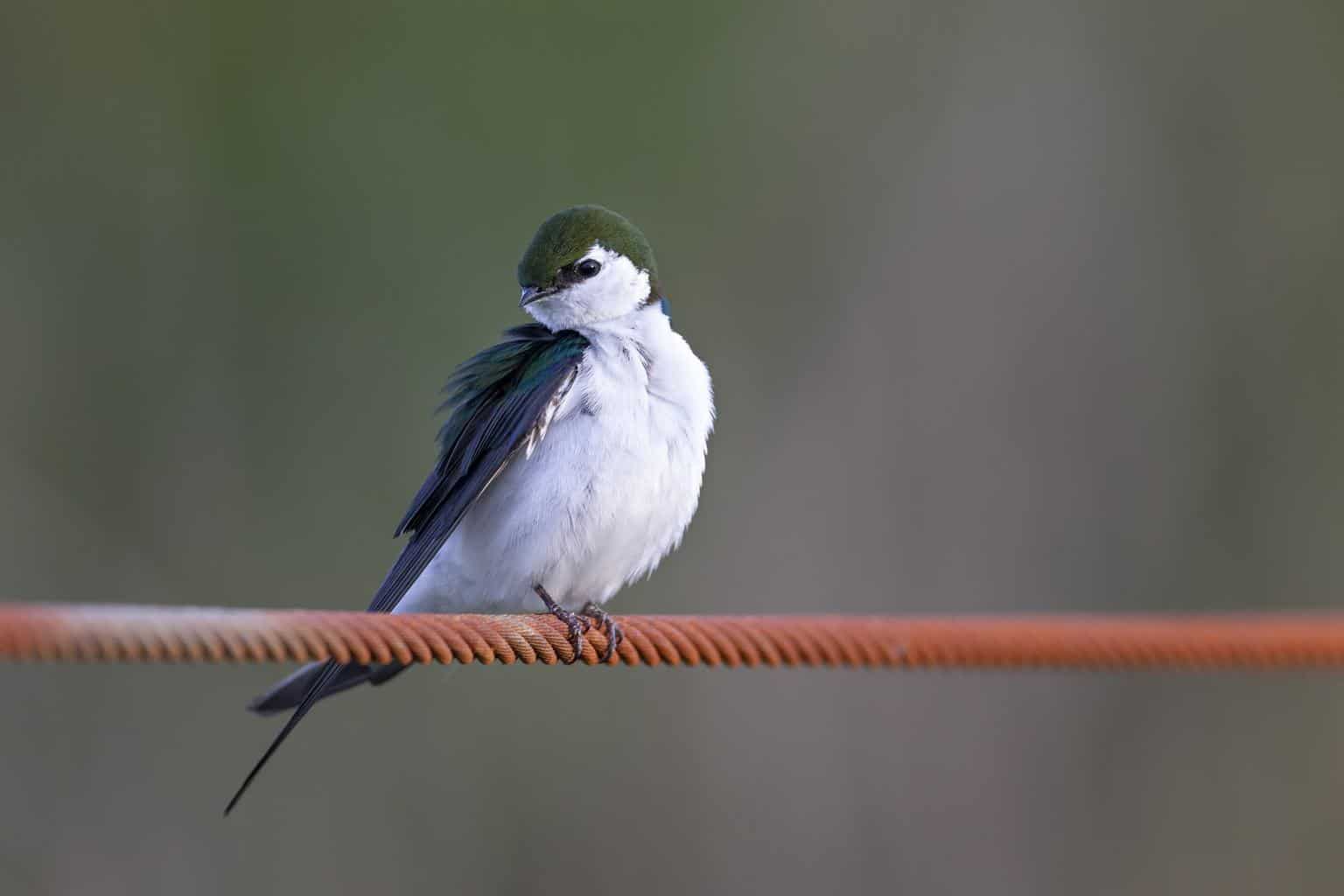
- Scientific name: Tachycineta thalassina
- Length: 4.7 in
- Weight: 0.5 oz
- Wingspan: 10.6 in
The presence of Violet-green swallows is dependent on two other creatures: woodpeckers and flying insects. Woodpeckers leave lots of tree cavities in their wake, which the Violet-green swallow turns into nests.
Regarding flying insects, this violet-green bird feasts on them. Since such insects typically exist in moist areas, the Violet-green swallow goes in search of them near bodies of water.
In this pursuit, the swallow does everything short of hanging a sign that says, “America’s most wanted,” with a picture of these water-loving insects on it.
Broad-Tailed Hummingbird
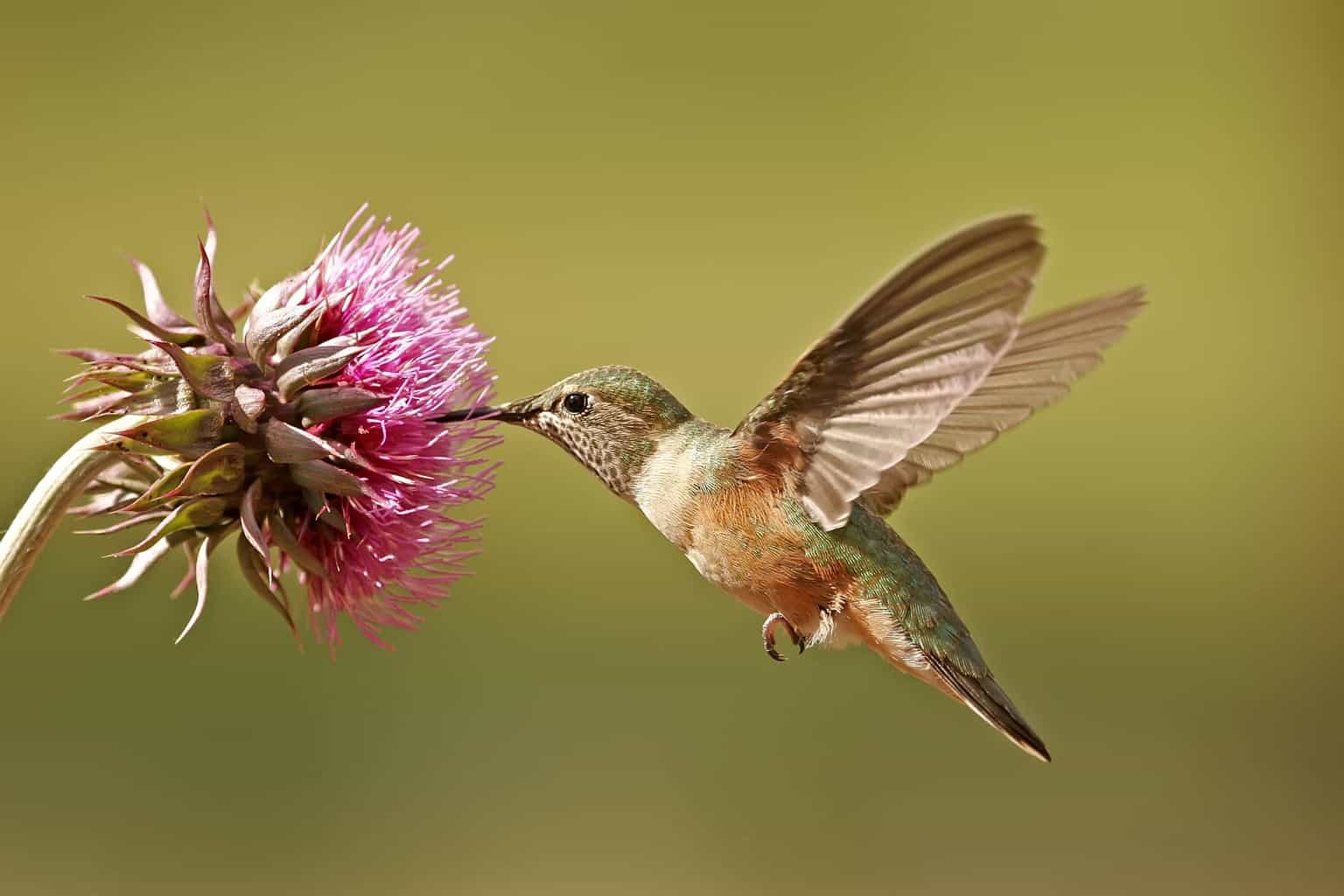
- Scientific name: Selasphorus platycercus
- Length: 4 in
- Weight: 0.13 oz
- Wingspan: 5.25 in
When you see it from afar, you might mistake the Broad-tailed hummingbird for a butterfly of sorts. I mean, it’s colorful, it hangs around flowers, and it isn’t that big, either.
Don’t let the cheerful colors and the fact that they feed on flower nectar fool you, though – Broad-tailed hummingbirds can get extremely territorial.
This charming flutter of their wings can sometimes be a warning signal they use to defend their territory. However, a variation of it can also be a way to attract females.
American Purple Gallinule
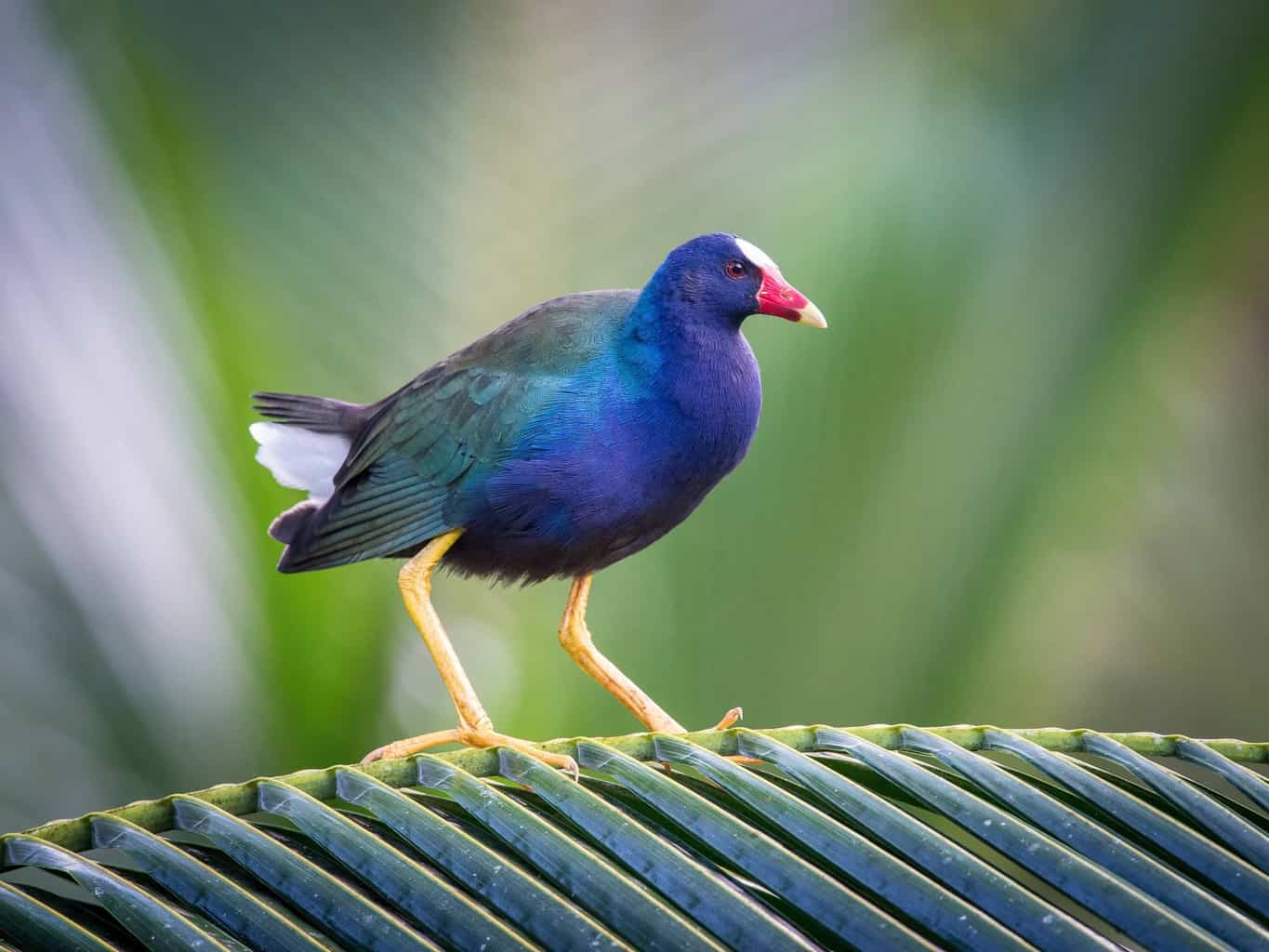
- Scientific name: Porphyrio martinicus
- Length: 10 – 15 in
- Weight: 5.0 – 10.8 oz
- Wingspan: 20 – 24 in
The way the American purple gallinule flies makes it look as though it’s doing high jumps. That’s because it flies for a short distance before descending back to the ground, and then the cycle begins anew.
How it flies isn’t the only thing that’s odd about this colorful bird, though. When it migrates, the American purple gallinule has no problem taking a break in the city. So, don’t get too confused when you see a stocky, green bird crossing the street beside you in Wyoming.
Mallard
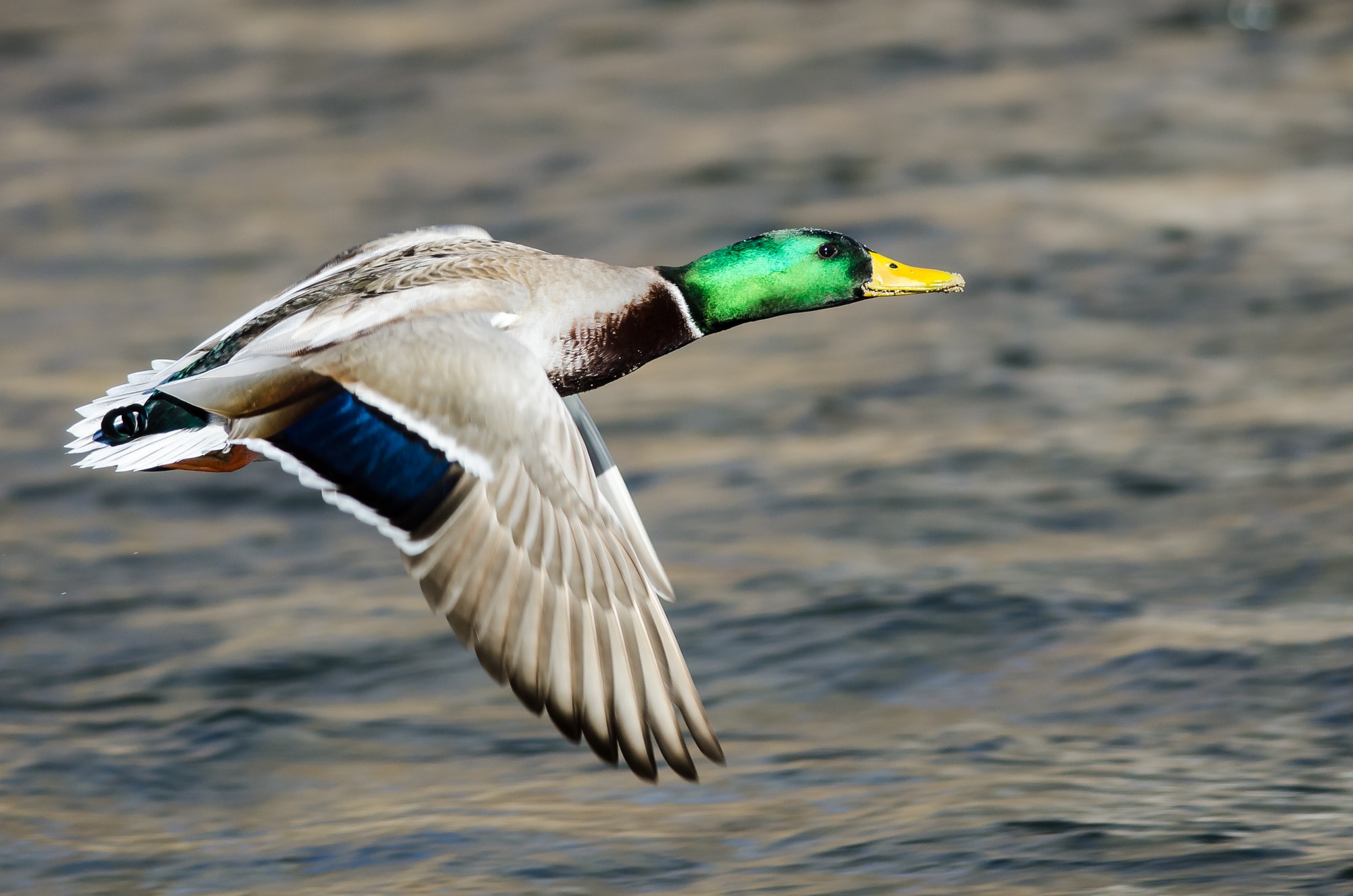
- Scientific name: Anas platyrhynchos
- Length: 20 – 26 in
- Weight: 24 – 56 oz
- Wingspan: 32 – 39 in
The dark green head and the white band around his neck make the male mallard unmistakable. Given how hard this guy works, we should really give him his due credit.
First, he has to compete with a bunch of other males in a joint display just to win the female’s heart. Even after a male succeeds, he still has to brace for the additional work that lies ahead.
Mating takes so much out of the male mallard that he loses his flight feathers, leaving him stuck on the ground for several weeks.
If spotting mallards is on your mind, then rivers and creeks should be marked on your map. In Wyoming, such mallard-rich water streams include Chugwater Creek.
Black-Chinned Hummingbird

- Scientific name: Archilochus alexandri
- Length: 3.5 in
- Weight: 0.1 – 0.2 oz
- Wingspan: 4.3 in
Hummingbirds are named so because of the humming sound their wings make in flight, and the Black-chinned hummingbird is the very best example of that – its wings beat so rapidly that it produces a characteristic buzzing.
It’s not only the wings that can make sounds, though. The Black-chinned hummingbird can hit a host of notes with its call.
Still, there’s one more part that can produce sounds in this DJ of a bird; the tail of a Black-chinned hummingbird collaborates with the wings to make a whistling sound to attract females.
Orange Birds in Wyoming
American Robin

- Scientific name: Turdus migratorius
- Length: 7.9 – 11 in
- Weight: 2.7 – 3 oz
- Wingspan: 12.2 – 15.8 in
The American robin is a bird that breeds at high speed. In one breeding season, an American robin pair can produce three sets of offspring. Sadly, however, this reproductive hyperactivity is counteracted by the insensitivity of predators.
Whether it’s bigger birds or sneaky snakes, both can’t seem to keep their hands off the robin’s precious eggs. Even squirrels pose a threat to the orange bird’s offspring.
The American robin is a familiar sight in Wyoming because it inhabits a host of habitats, from forests to grasslands. If you head to the Ashley National Forest, for example, you’re sure to run into one of these orange birds.
Varied Thrush
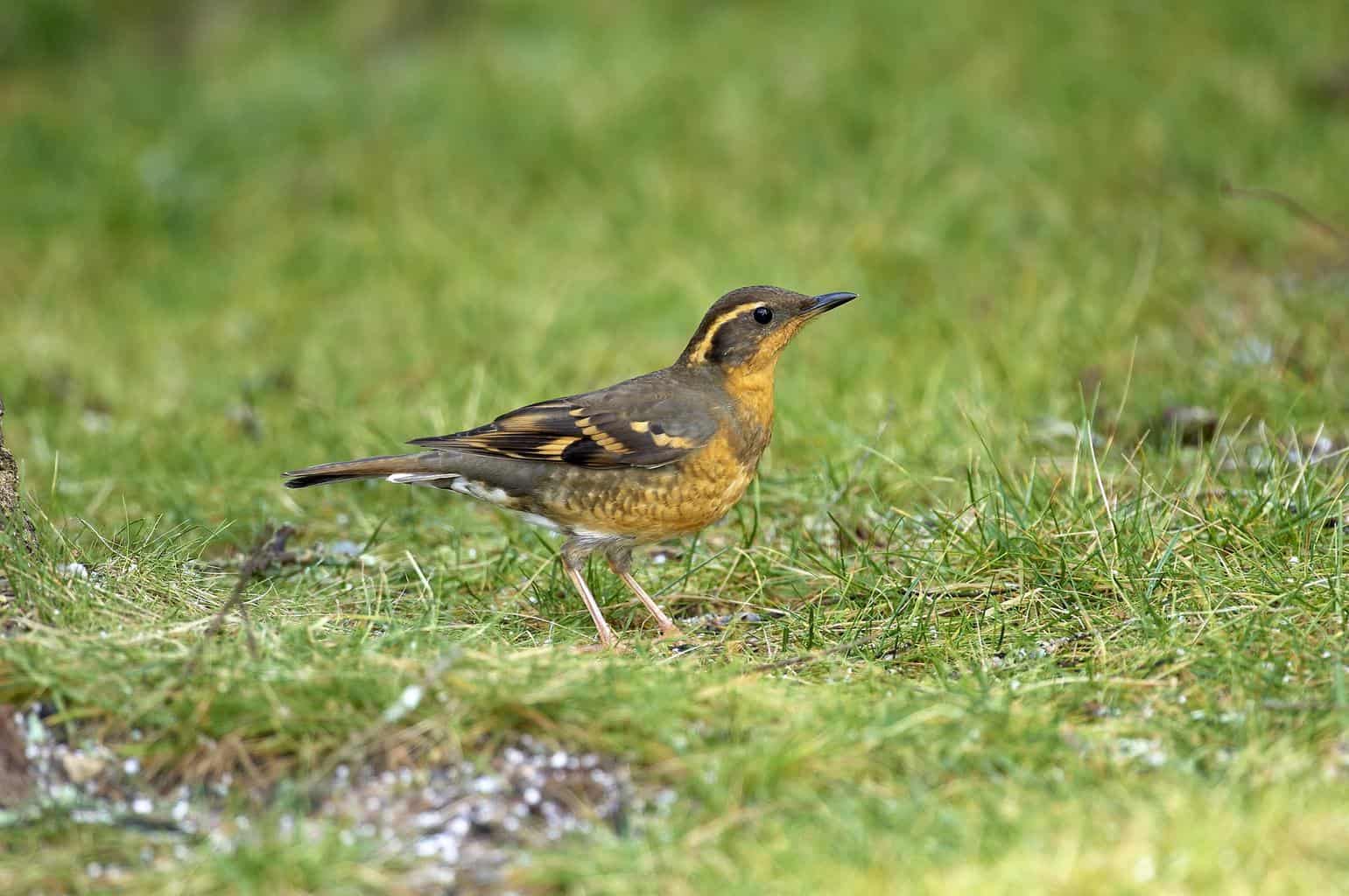
- Scientific name: Ixoreus naevius
- Length: 7.9 – 10.2 in
- Weight: 2.3 – 3.5 oz
- Wingspan: 13 – 17 in
This orange-black bird is vulnerable to the effects of forest cutting, a behavior that’s still common in this day and age in Wyoming and the Northwest at large.
On the upside, the Varied thrush is diverse when it comes to the habitats it can survive in, which include:
- Wet forests
- Coniferous forests
- Thickets
- Ravines
- Near streams
Brambling
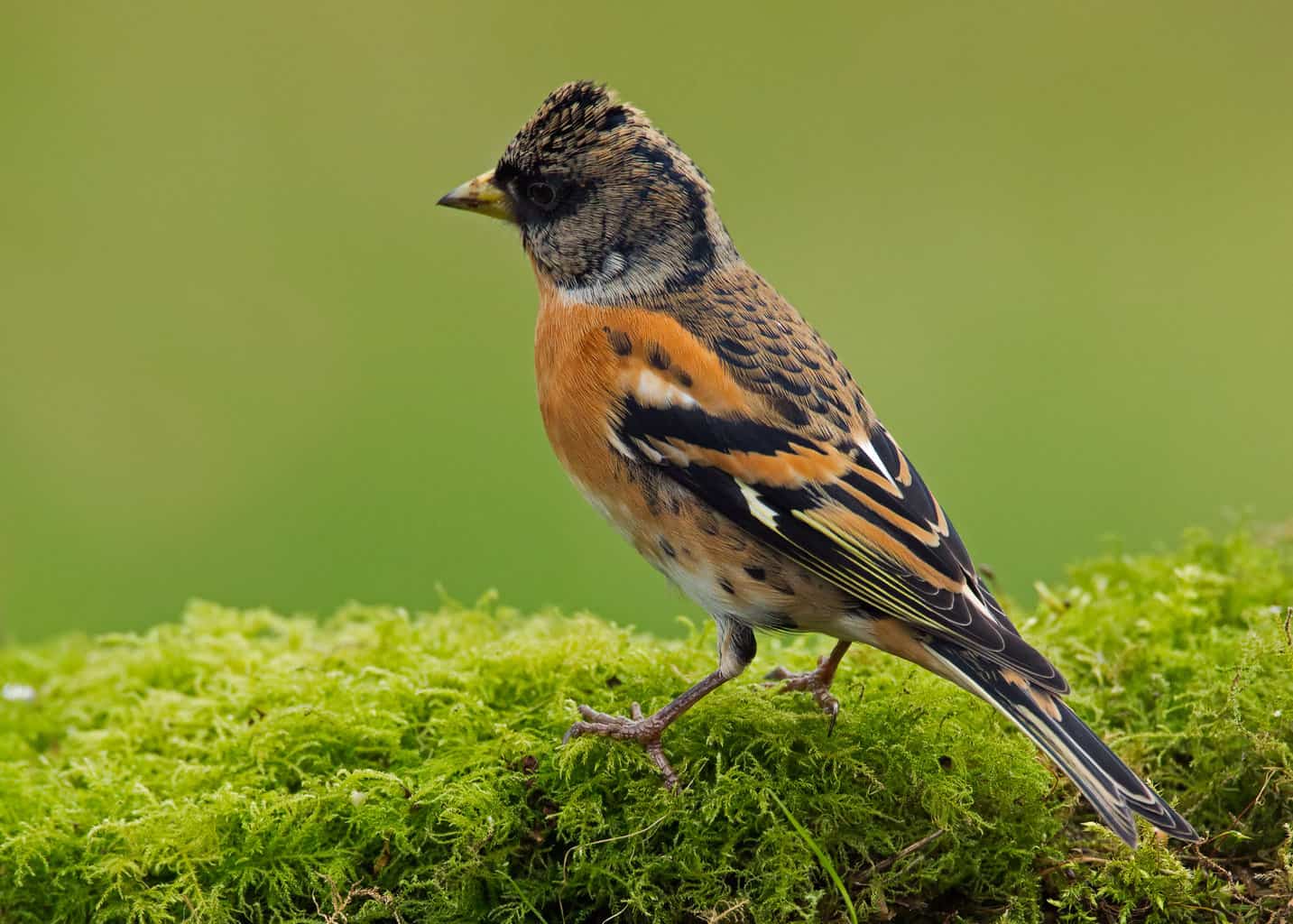
- Scientific name: Fringilla montifringilla
- Length: 6.29 in
- Weight: 0.8 – 1.02 oz
- Wingspan: 9.8 – 10.2 in
Winter seems to take a toll on the health of this orange-chested bird. The brambling looks for food on the ground, and when the snow interferes with that, it forces the bird to fly away. It’s certainly not one of nature’s winter birds.
Even when the cold wind is free from snow particles, the brambling still leaves behind its feeding ground—because it resorts to coniferous trees that are sheltered from the wind.
In Wyoming, expect to see much of this bird in the winter because it stays near agricultural fields during that season. Of course, with the Great Plains running through it, Wyoming has no shortage of such fields.
Orchard Oriole
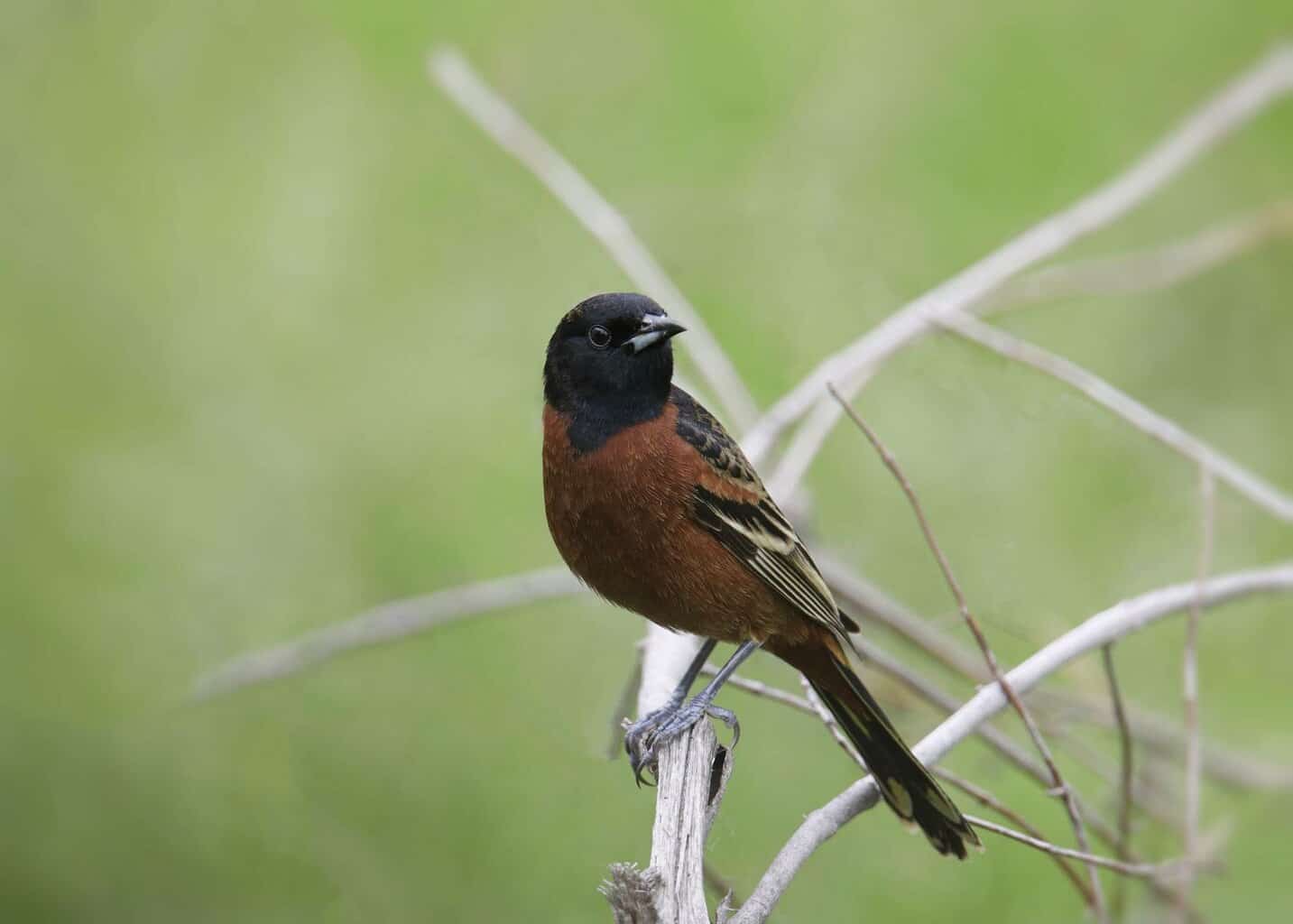
- Scientific name: Icterus spurius
- Length: 5.9 – 7.1 in
- Weight: 0.6 – 1.0 oz
- Wingspan: 9.8 in
If you live in Wyoming and decide to set up a hummingbird nectar feeder, you may end up getting more than you bargained for. In addition to hummingbirds, a dark-orange bird will tag along: the Orchard oriole.
This bird loves nectar as much as the next guy. Of course, by the “next guy,” I mean hummingbirds. The Orchard oriole isn’t exclusively wedded to nectar, though. It also eats protein-rich insects, which helps keep its orange pecs pumped up.
Black-Headed Grosbeak
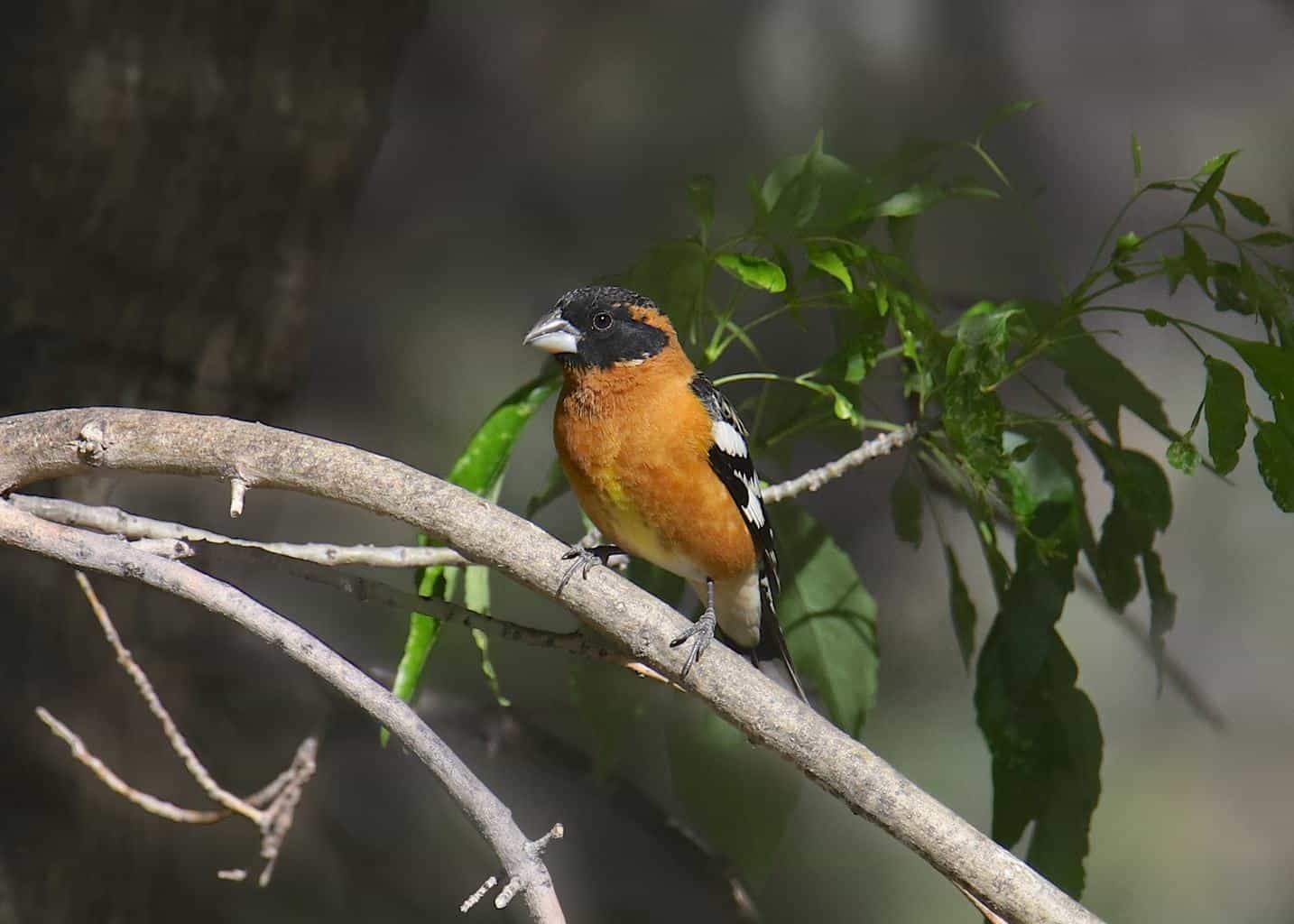
- Scientific name: Pheucticus melanocephalus
- Length: 7.1 – 7.5 in
- Weight: 1.2 – 1.7 oz
- Wingspan: 12.6 in
This breed of grosbeak isn’t only black-headed, but it’s also hard-headed. You just need to see two of those orange-brown males locking horns over a territory, and the aggression displayed might leave you a little shaken.
That’s especially the case if the two fighting birds are older males because they often get the finest territories. So, when you put two well-established, ego-driven males in the same ring, you better keep your distance!
Yellow Birds in Wyoming
Hooded Warbler
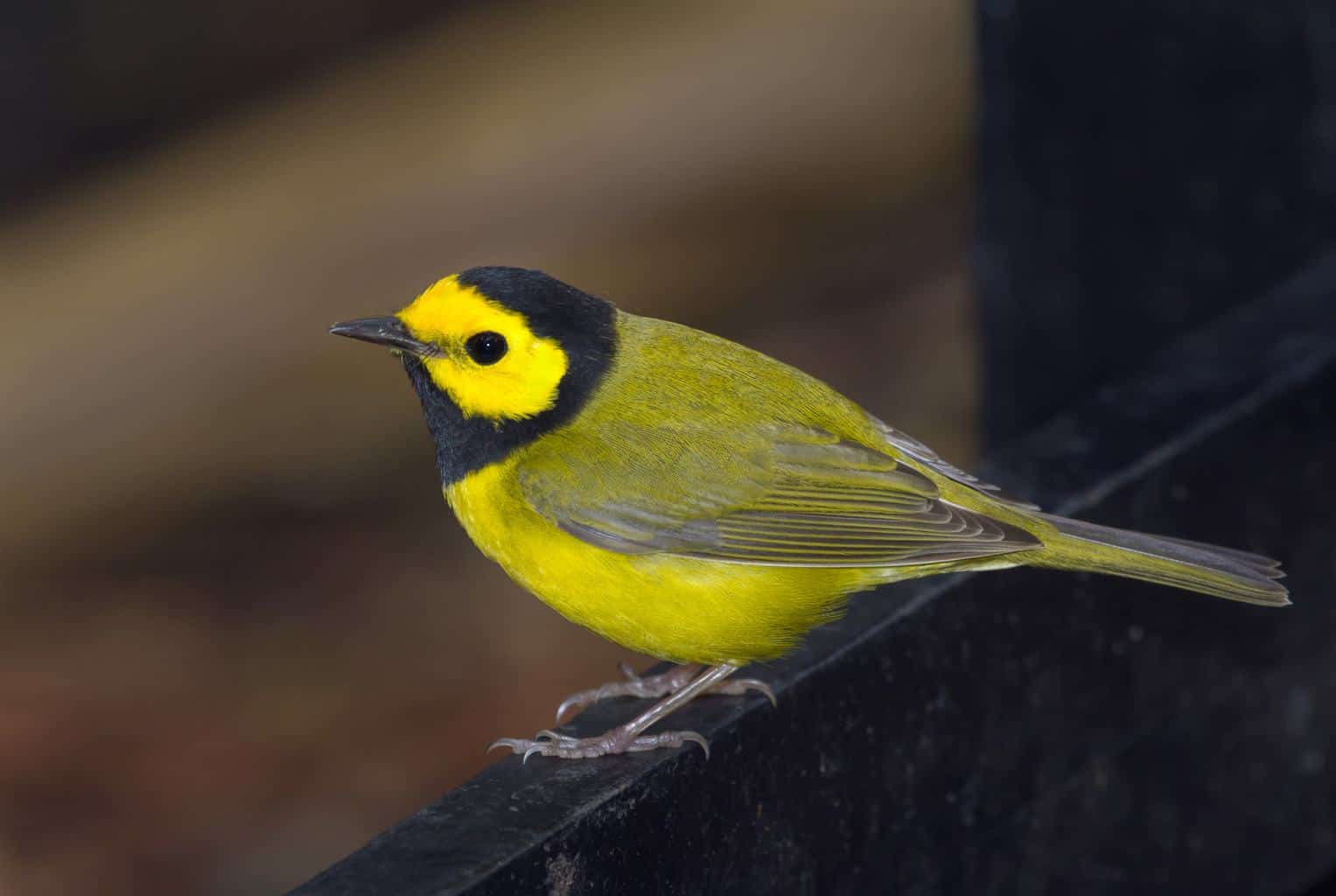
- Scientific name: Setophaga citrina
- Length: 5.1 in
- Weight: 0.32 – 0.42 oz
- Wingspan: 6.9 in
Upon mentioning the Hooded warbler, people quickly marvel at its flashy yellow color. But what about the black hood it sports over its head? This thing gives it the enigmatic vibe of a late-night vigilante!
Appropriately enough, the Hooded warbler always migrates at night – which doesn’t end well on many occasions. The poor warbler often bumps its head against the glass that was rendered invisible by the pitch-black night.
On a cheerful note, there have been many organizations taking action to minimize the warbler’s encounters with glass windows. This way, the bumblebee-looking bird can travel without getting hurt.
American Goldfinch
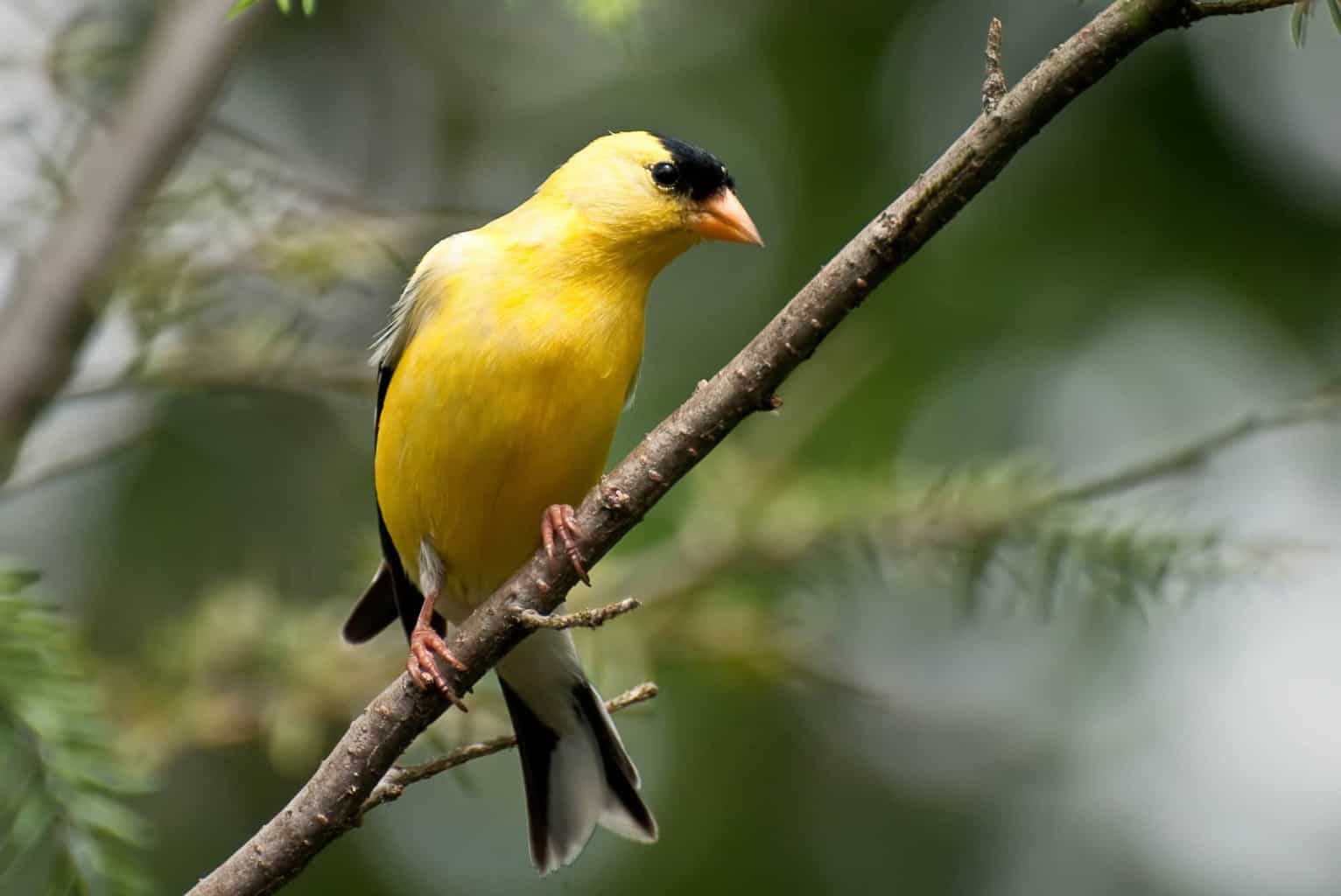
- Scientific name: Spinus tristis
- Length: 4.3 – 5.5 in
- Weight: 0.39 – 0.71 oz
- Wingspan: 7.5 – 8.7 in
Yellow seems to not only cover the American goldfinch’s body but also run in its blood. I mean, have you seen the way these finches go crazy over sunflowers?
That’s why the American goldfinch is one of the easiest birds to attract to your backyard—all you need is a sunflower feeder.
Aside from frequenting backyards, the American goldfinch also hangs around parks and suburbs. Maybe it’s humans that this bird is secretly attracted to and not sunflowers!
Yellow Grosbeak
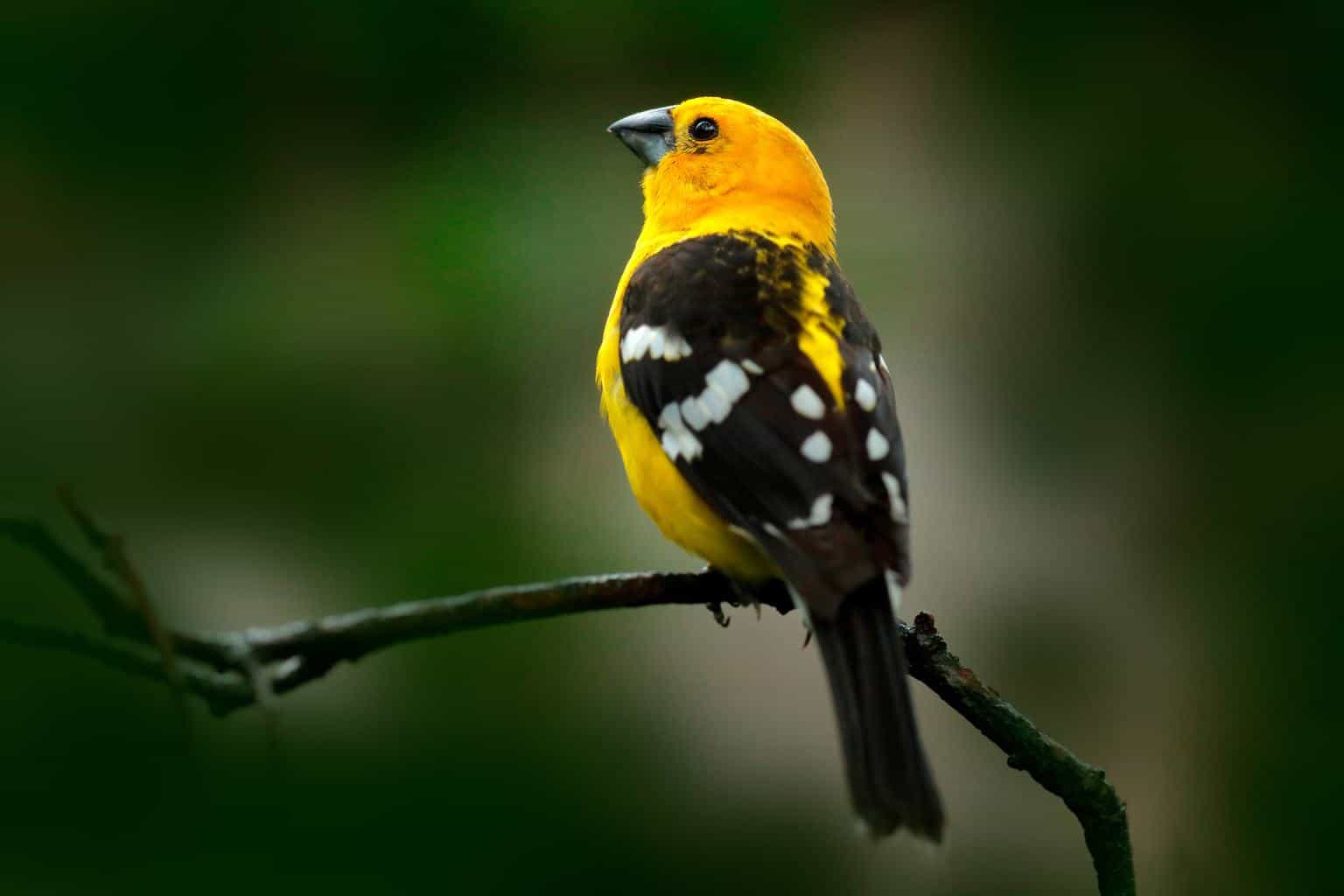
- Scientific name: Pheucticus chrysopeplus
- Length: 8.5 – 9.4 in
- Weight: 2.2 oz
- Wingspan: 14.5 in
The Yellow grosbeak is mostly a year-round resident in the areas where it lives. Migration is minimal, even though it’s slowly expanding its range up North.
This state of being largely stationary may have done the Yellow grosbeak a disservice. That’s because the numbers of these popular birds seem to be decreasing, albeit not to an alarming extent.
Regarding its diet, the Yellow grosbeak feeds on:
- Fruits
- Seeds
- Berries
- Spiders
- Small insects
Yellow-Breasted Chat
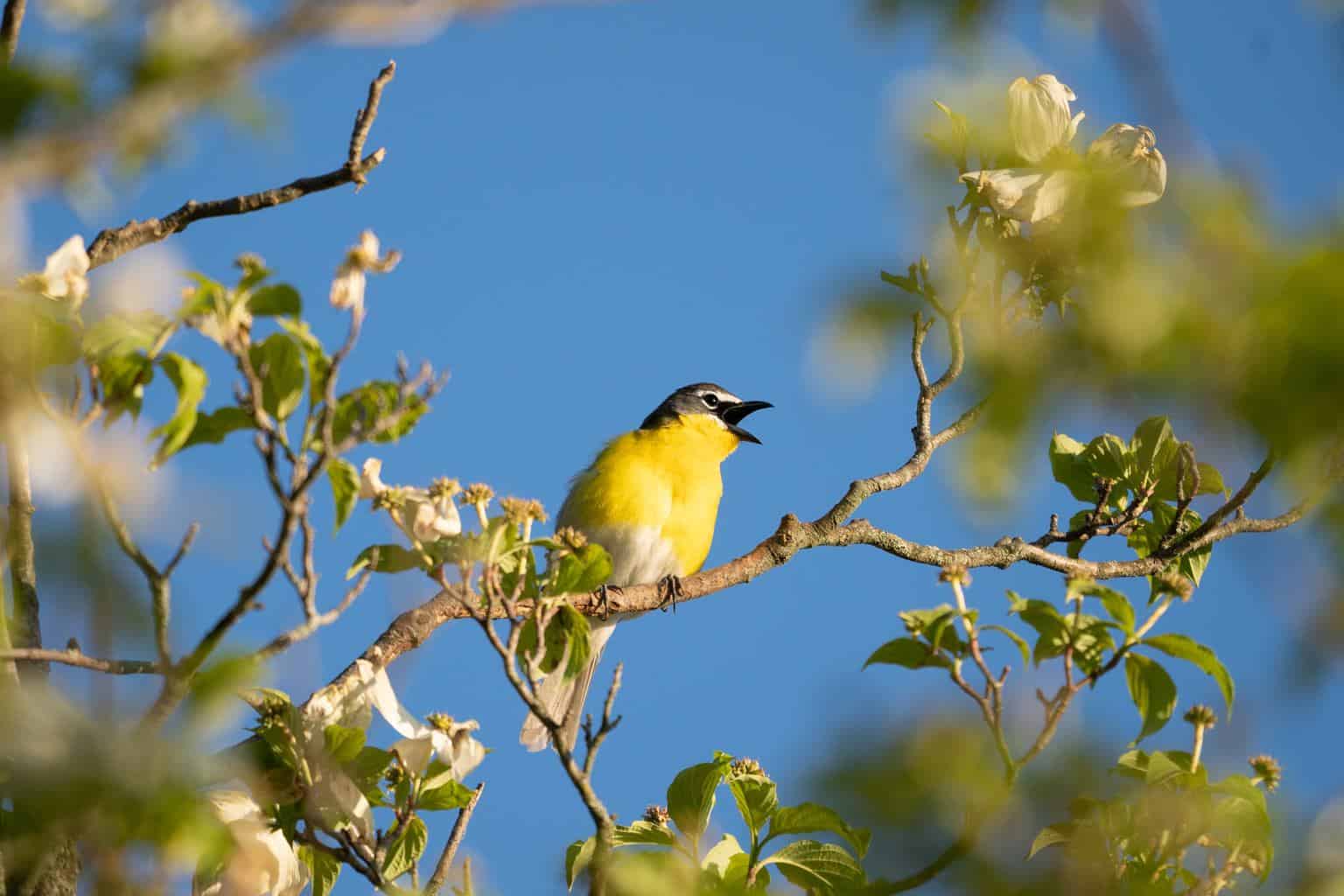
- Scientific name: Icteria virens
- Length: 6.7 – 7.5 in
- Weight: 0.71 – 1.19 oz
- Wingspan: 9.1 – 10.6 in
Despite being one of the largest warblers, the Yellow-breasted chat often remains unseen. It navigates the thickets on its own in search of food instead of joining conspicuous feeding packs like many other bird species.
The Yellow-breasted chat doesn’t keep a low profile at all times, though. On occasions, it seems to catapult itself in the air in bursts of energy and start singing never-before-heard melodies.
The yellow-breasted bird does this to win over a female, with other moves added to the dance – like swaying from side to side, for example.
Yellow-Throated Vireo
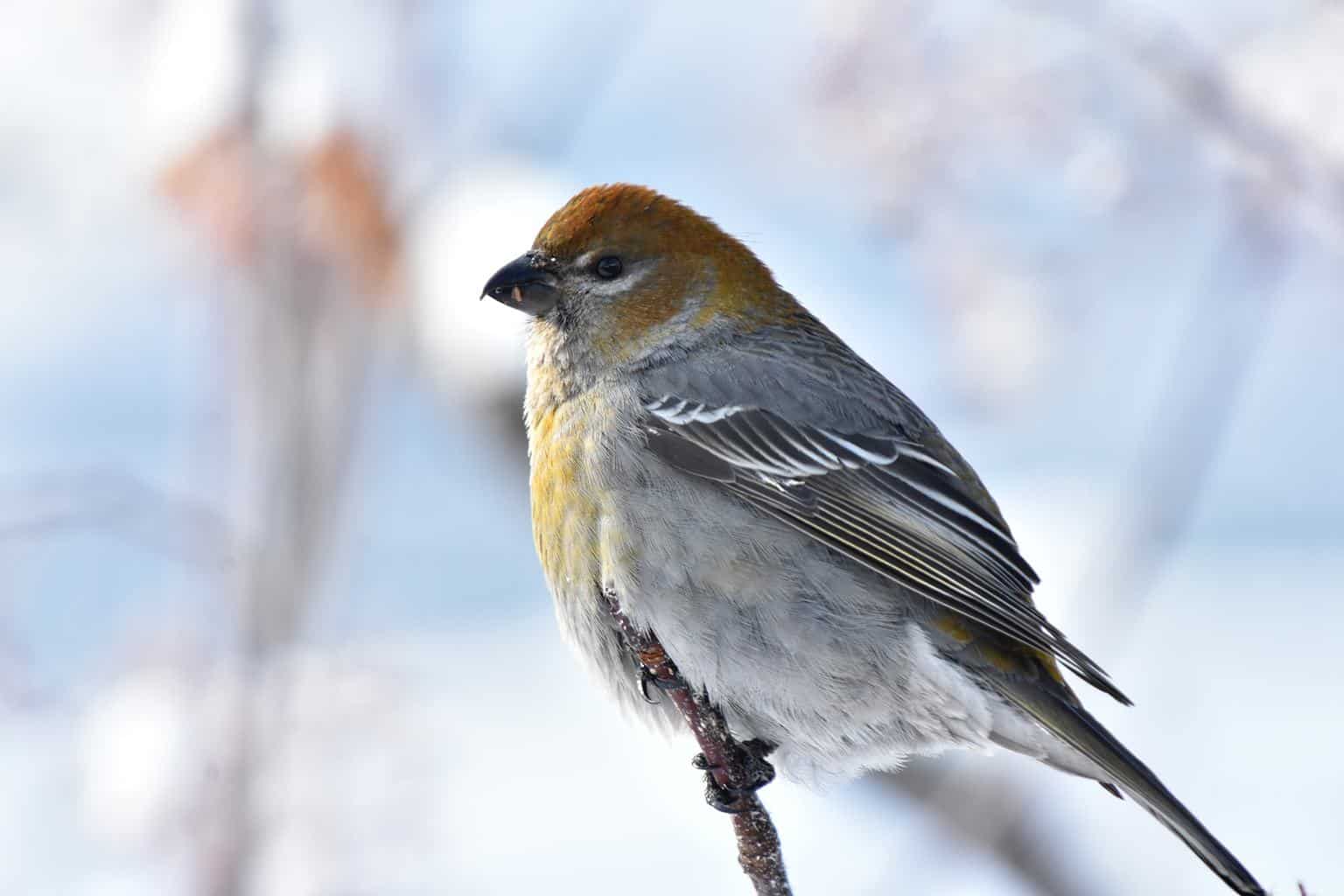
- Scientific name: Vireo flavifrons
- Length: 5.1 – 5.9 in
- Weight: 0.5 – 0.7 oz
- Wingspan: 9.1 in
While webs are known to be homes for spiders, that doesn’t mean other creatures can’t benefit from those sticky threads.
Taking a trick from Spiderman, the Yellow-throated vireo also uses spider webs – they make for a great glue that holds together plants and twigs to ultimately create a stable nest.
Given that the Yellow-throated vireo feeds on spiders, it looks like those eight-legged arachnids are an asset to the vireo.
Lucky for them, those victimized spiders have found someone to get revenge on their behalf: the Brown-headed cowbird. These cowbirds often invade the nests of the Yellow-throated vireo—bringing about the demise of the vireo’s offspring.
Other Birds to Watch for in Wyoming
Brown-Headed Cowbird
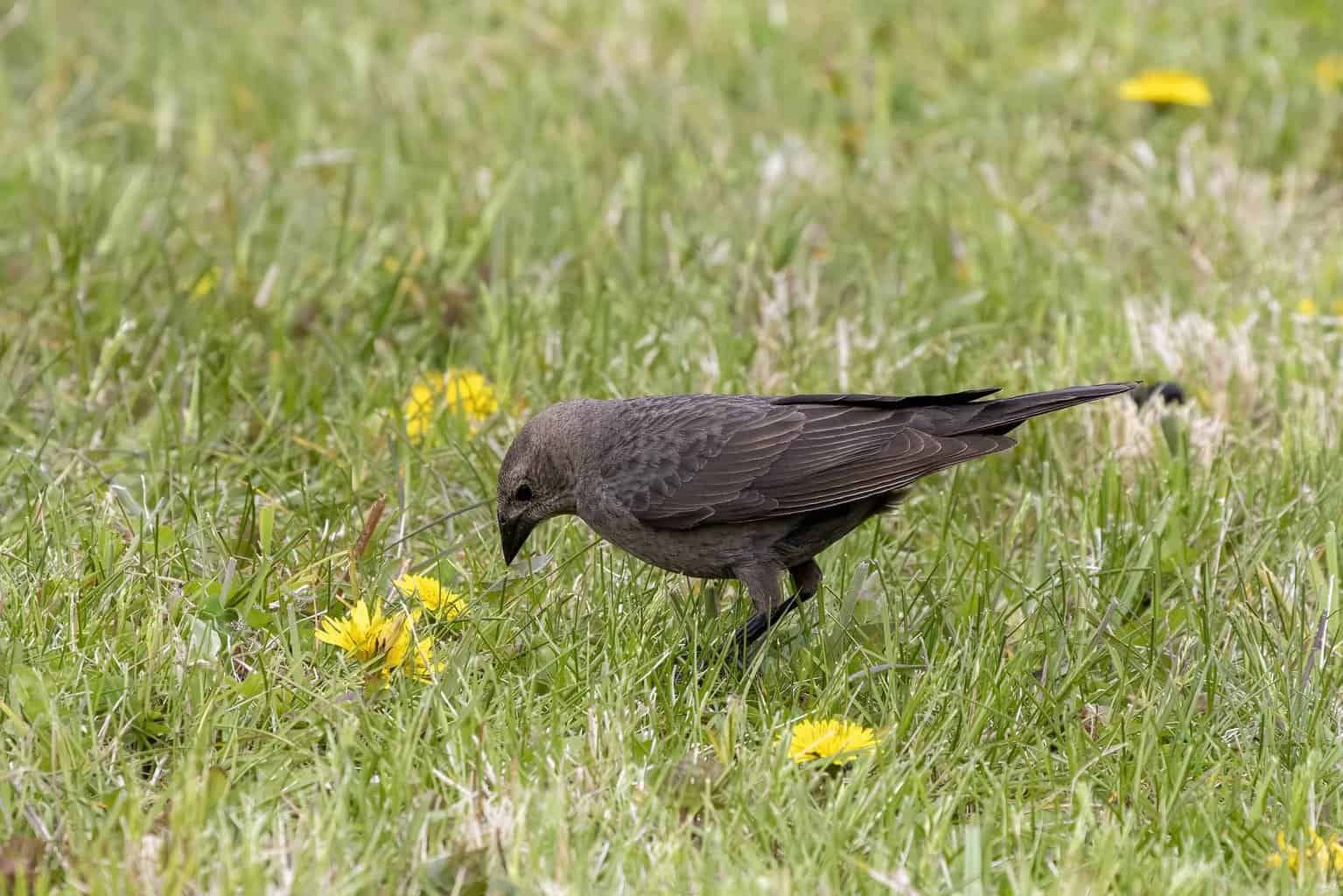
- Scientific name: Molothrus ater
- Length: 6.3 – 8.7 in
- Weight: 1.1 – 2.1 oz
- Wingspan: 14 in
The Brown-headed cowbird doesn’t build nests, instead, it trespasses on those built by other birds. Among the victims is the previously mentioned Yellow-throated vireo.
The female of the Brown-headed cowbird lays an abundance of eggs – up to three dozen per breeding season.
Then, instead of building them a home, the cowbird drops its offspring off at other nests without asking permission from the property owners.
The extra chicks feed at the expense of the original ones, causing many of the latter group to have a short-lived existence.
Great Grey Owl
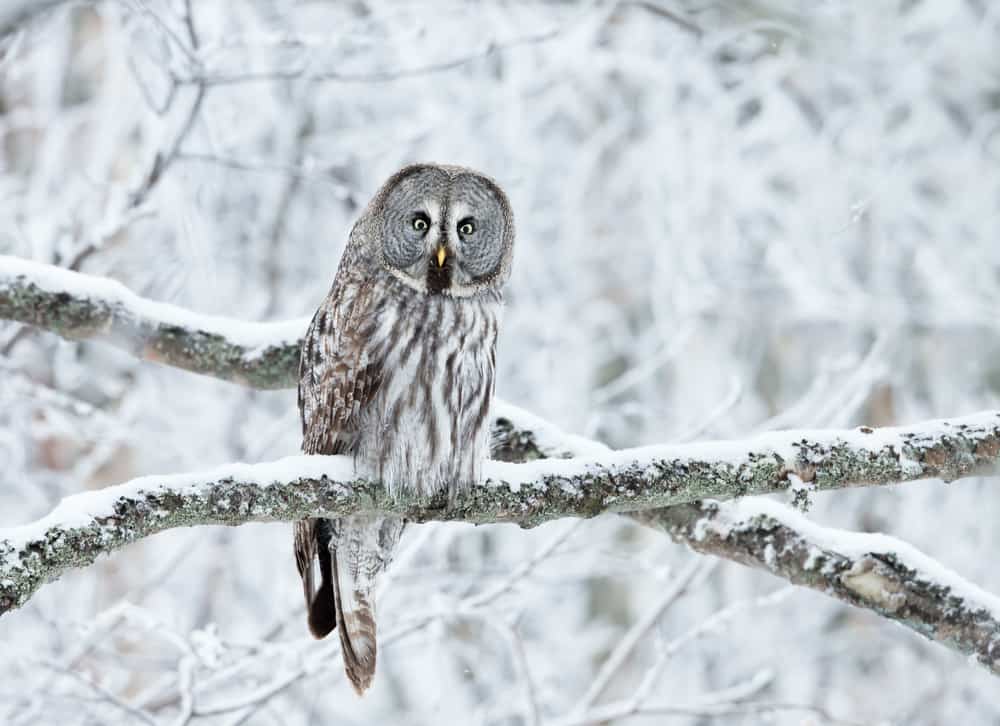
- Scientific name: Strix nebulosa
- Length: 24 – 33 in
- Weight: 24.7 – 60 oz
- Wingspan: 53.9 – 60.2 in
The tallest owl in all of North America, the Great grey owl has a history of attracting people from far and wide to see it. In one instance, this owl was spotted in Massachusetts. This led to an influx of 3,000 birders over the span of 2 months in the state.
A great part of this owl’s charm lies in its majestic size, especially when it spreads its wings.
However, you’ll be surprised to know that much of that size is created by puffy feathers. If we were to examine the actual mass of its body, we’d find out it’s half that of the infamous Great-horned owl.
That’s why, despite being a raptor itself, the Great grey owl often falls prey to greater, mightier predators.
Golden Eagle
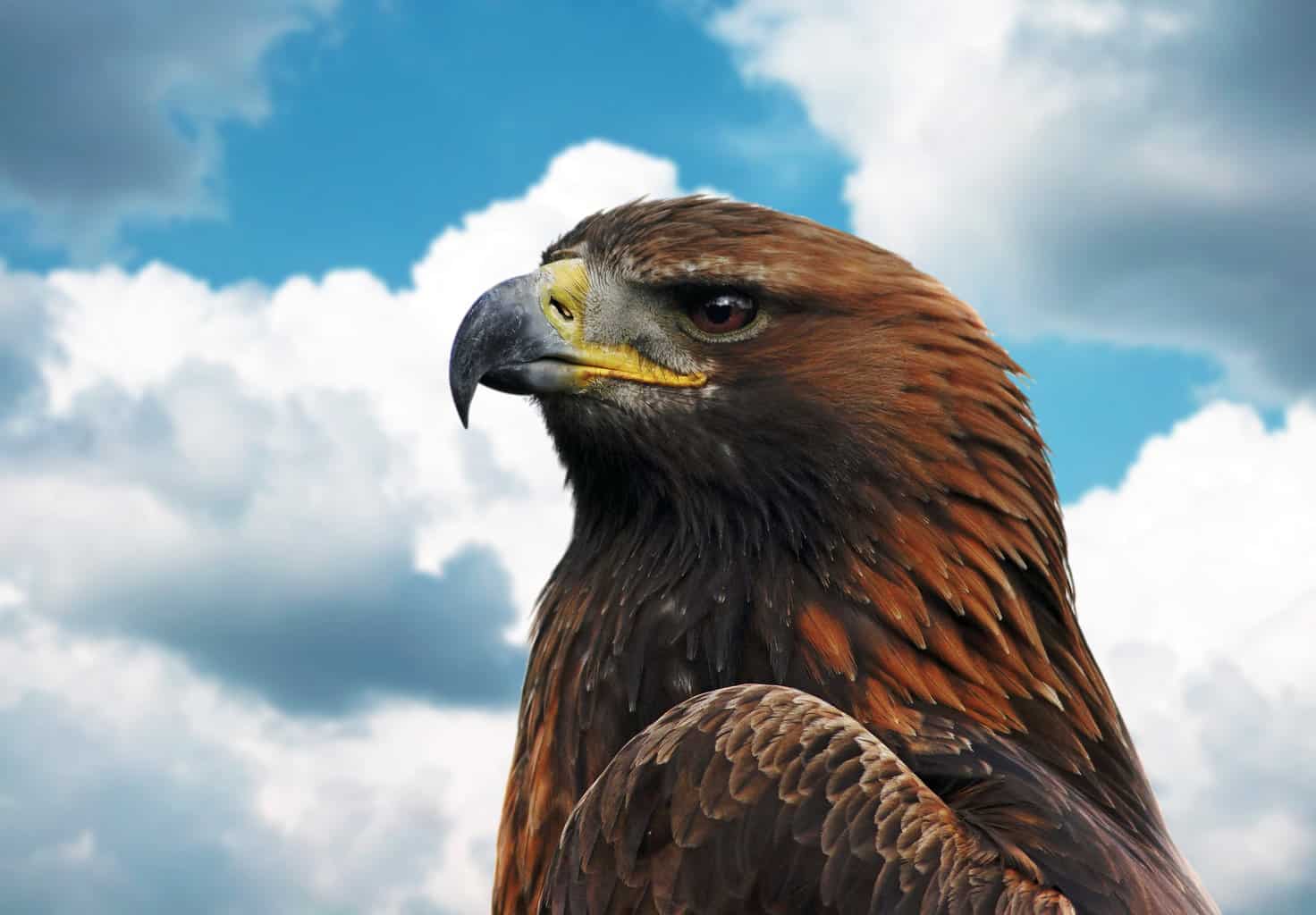
- Scientific name: Aquila chrysaetos
- Length: 27.6 – 33 in
- Weight: 106 – 216 oz
- Wingspan: 73 – 86.6 in
When trying to sight the Golden eagle, make sure to do so from a safe distance. Get too close to the nest, and you put yourself at risk, as this eagle doesn’t show much tolerance for humans.
The Golden eagle is both hostile and powerful, hunting prey as big as foxes and cranes. When a male eagle teams up with its significant other to hunt, it’s nearly impossible for the prey to escape. Even if it somehow was able to evade the first eagle, the other will be waiting with a knife and a fork.
Of course, you know that when a couple hunts together this way, they’re creating an unbreakable bond.
It shouldn’t come as a surprise, then, that when the Golden eagle pairs, they may stick with each other for a lifetime.
Final Words
Between great raptors and cute songbirds, Wyoming has got it all. There, you’ll find some highly sought-after birds, like the Great grey owl.
You’ll also get to meet other unassuming yet no less charming species, like the mallard and the American robin.
In short, Wyoming is the perfect place for a birder to be, either as a resident or a visitor!

